Sport and anime are two things that bring people together more than anything else. People from all around the world can bond over their shared liking of an anime or a sportsperson.
The world of sports and anime is extremely entertaining. But what happens when both of these are mixed together? The viewers get a whole new level of enjoyment. The anime sports genre boasts a huge array of amazing shows, covering just about every sport you can think of, real and fictional, that the viewers can enjoy.
These shows are exciting and action-packed, featuring some of the most interesting stories in the medium. The drama, the intensity, and the entertainment are just amplified manifolds by anime. There are several hallmarks of shounen, namely its blend of action, comedy, and tragedy combined with a plucky protagonist with a never-quit attitude.
It is similar to a well-written drama, only with sports involved. The characters need to be interesting with different motivations and rich backgrounds that make you want to cheer or boo them.
Watching athletes in action is an exciting experience in the world of sports. They provide an edge-of-the-seat experience without waiting for the big game day. The thrill never stops in these stories as our heroes overcome challenges both on the field and off!
So here are some sports anime we think have strong characters, well-done drama, and great animation.
Haikyuu!!
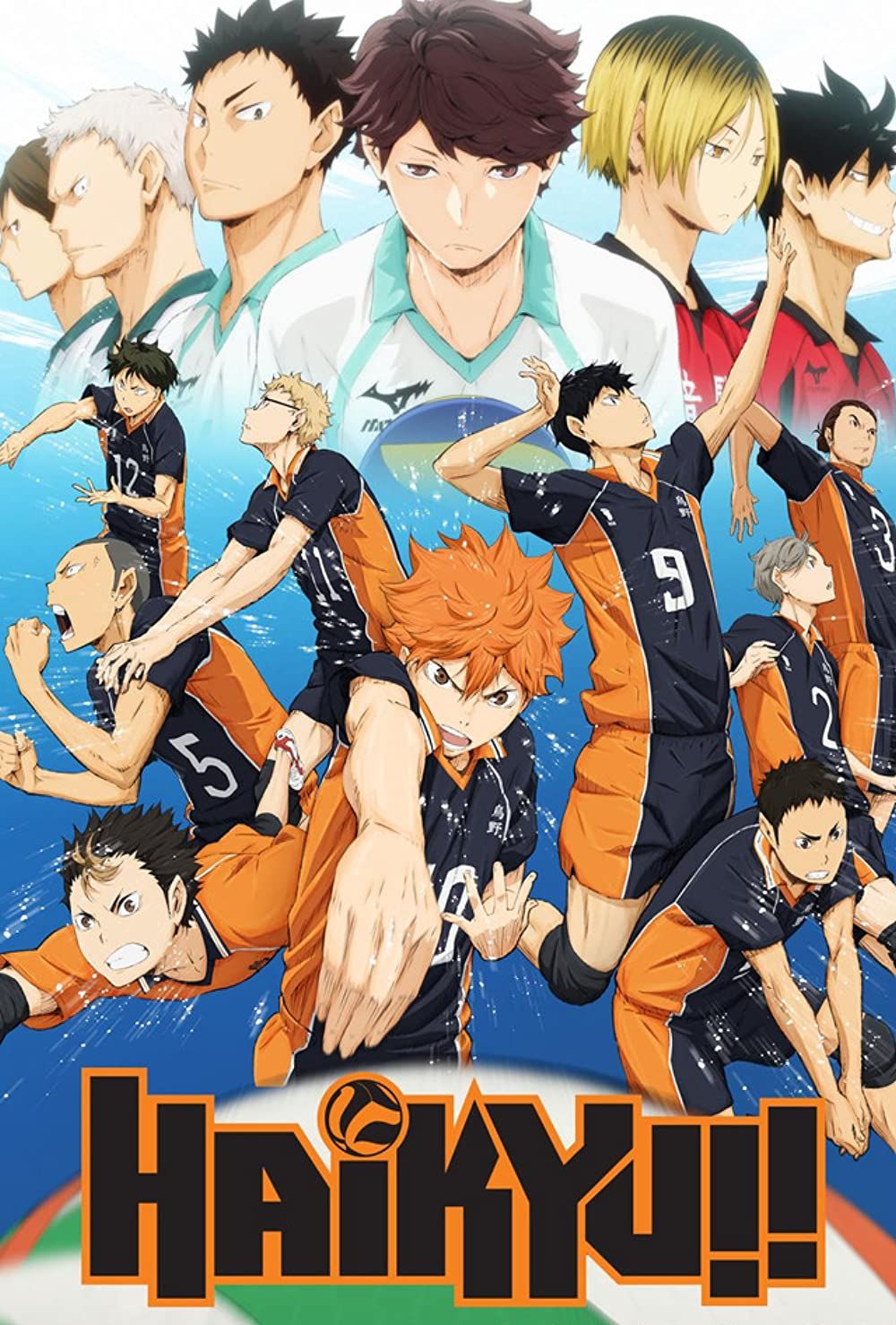
Shouyou Hinata was inspired to revive the volleyball club at his middle school after watching a volleyball ace nicknamed “Little Giant” in action. As a newly-formed team, they even make it to a tournament, but their first match ends in defeat when they are brutally crushed by Tobio Kageyama, the “King of the Court.”.
In an effort to surpass Kageyama, Hinata joins Karasuno High School’s volleyball team after graduating middle school only to discover that Kageyama is now his teammate.
Even with his superior jumping ability, Hinata struggles to find his place on the team due to his short height. To everyone’s surprise, Kageyama is facing his own difficulties that only Hinata can resolve, so learning how to cooperate will be key to the team’s success. Two determined athletes face a heated rivalry as they attempt to patch things up so that they can make their high school volleyball team the best in Japan.
Basically, it’s a bunch of shounen stereotypes. You have an underdog, there is teamwork, and there is perseverance. But Haikyuu!! does a fantastic job of integrating all of these themes.
The protagonists are relatively inexperienced and far from being the best volleyball players in the world. There are no bizarre achievements and no crazy ‘level-ups.’ As a result, we have a nicely written and paced story that follows the formation of the Karasuno team to their entry into the high school volleyball circuit.
Relationships between players develop in many ways: as friends, as teammates, as students in different grades, or as a cohesive team against another team. Volleyball is somewhere in the middle. You can see why it’s so beloved by the characters, and you can see how their love developed.
Hajime no Ippo
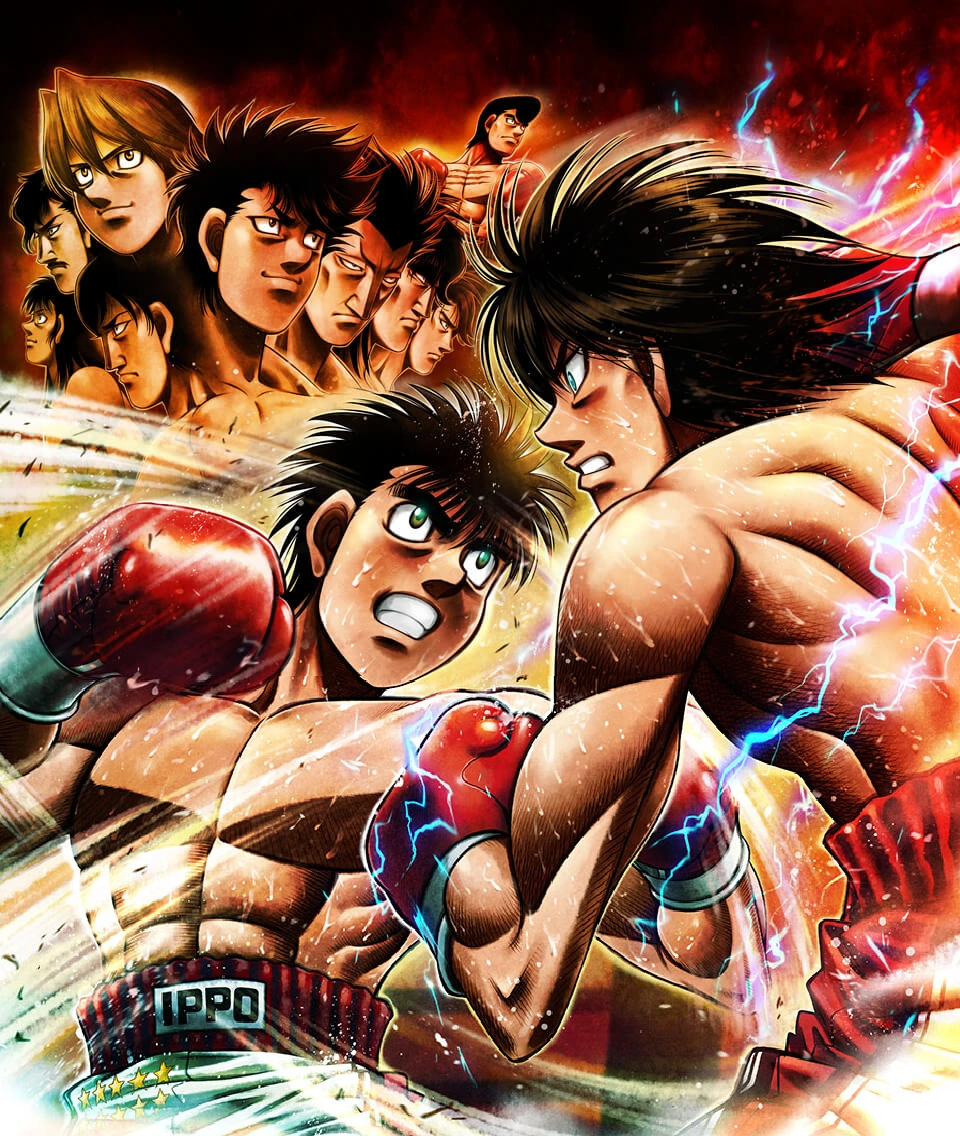
Makunouchi Ippo has always been bullied. Ippo has always wished to change but has never had the courage to take action. He is constantly running errands and getting beaten up by his classmates. In the midst of another bullying incident, Ippo is saved by Takamura Mamoru, a boxer.
Fainting due to his injuries, Ippo is brought to the Kamogawa boxing gym to recover. When he regains consciousness, he is amazed and awed by his new surroundings in the gym but lacks the confidence to attempt anything. Ippo is forced to punch a photo of his classmate on a punching bag by Takamura. Eventually, Ippo feels something stir inside him and asks Takamura to train him in boxing.
Takamura gives Ippo a task he believes impossible and gives him a one-week deadline, believing that he does not have the skills. With an intense desire to grow stronger, both for him and for his hardworking mother, Ippo trains relentlessly to meet the deadline. In this way, Ippo’s journey to the top of the boxing world begins.
This anime is undoubtedly special because of its characters. You root for the characters in the end because they’re so likable, original, and well-developed.
Those who only last one episode, as well as Ippo’s opponents, have such plausible and compelling backstories that you might find yourself rooting against him for a match or two. It just makes you feel like such a world could exist because these characters appear to be so serious with their lives.
A highly entertaining anime series that captures the essence of boxing, with some truly memorable fights, is Hajime no Ippo.
Kuroko no Basket
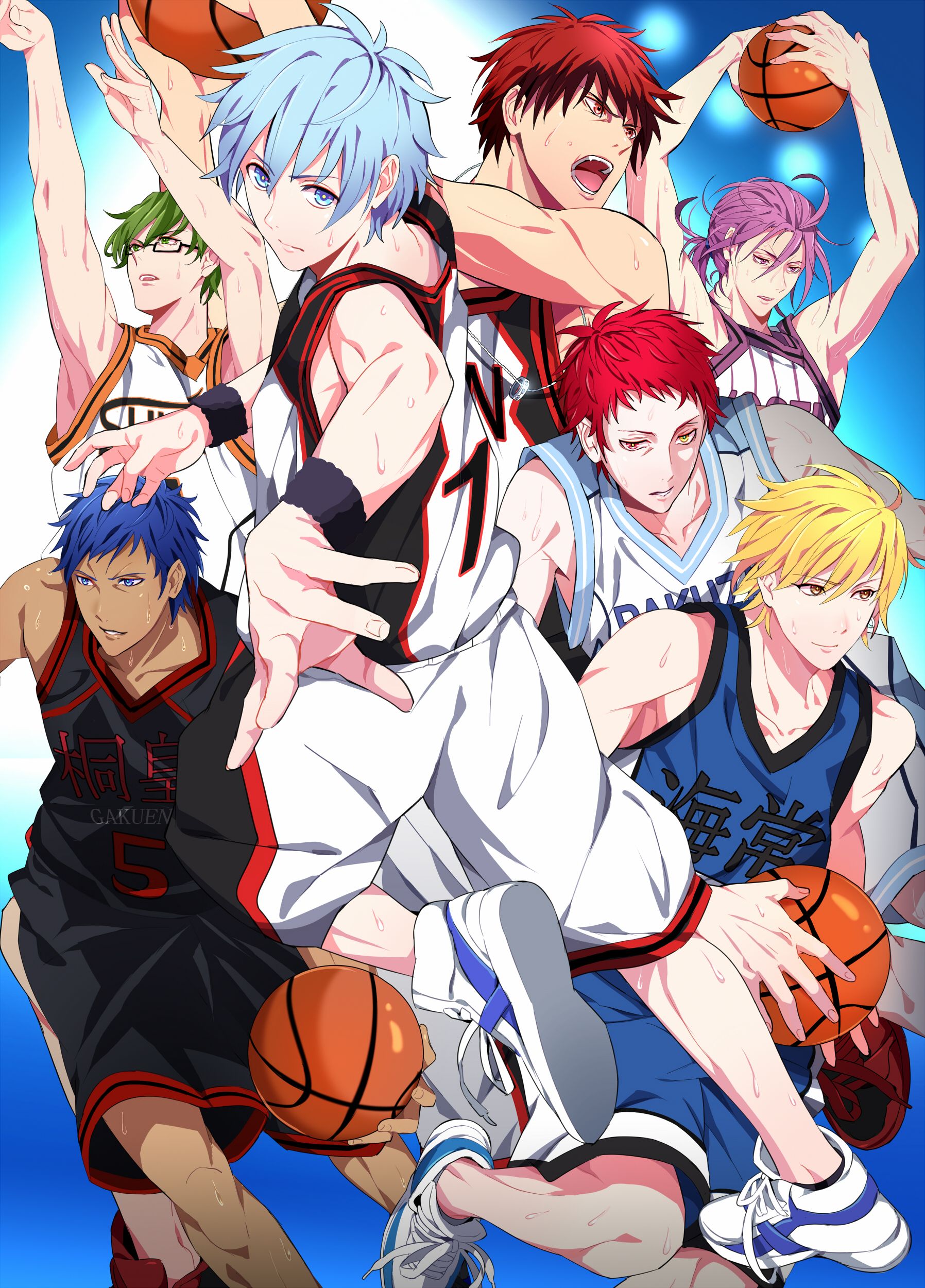
In the last three years, Teikou Middle School has dominated the national basketball scene with its legendary lineup: the “Generation of Miracles.” The team consisted of five prodigies who excelled at basketball, but a “Phantom Sixth Man” helped earn the team its venerated status. They eventually lost interest in the sport they loved due to their monstrous growth and went their separate ways in high school.
Taiga Kagami and Tetsuya Kuroko are two freshmen who seem to have very different abilities, are recruited by the Seirin High School basketball team as new members. Kagami, who returned recently from America, possesses a natural aptitude and a relentless love for the sport. In contrast, Kuroko lacks physical presence and has no exceptional athletic ability. The player is revealed to be Teikou’s Phantom Sixth Man, once a member of the Generation of Miracles.
In his own way, Kuroko wants to prove himself to the Seirin team. Seeing Kuroko’s conviction, Kagami forms a dynamic partnership with him; the latter promises to act as the “shadow” to his “light.” As they prepare for the Interhigh championship with their new Seirin teammates, Kuroko’s former teammates return to disrupt their plans.
It’s not so much of a huge monster; more of a little guy who causes a lot of hype, and it’s exciting to see what fate holds in store for him, he’s the underdog that you cheer for.
As much as you are drawn to the anime for its sports component, you will also appreciate it for its school and story elements. It’s packed with action and story and has just the right amount of both! The character development is amazing, and you get to know all the best players from the best teams.
https://www.youtube.com/watch?v=l8AgFqbKjGA
Slam Dunk
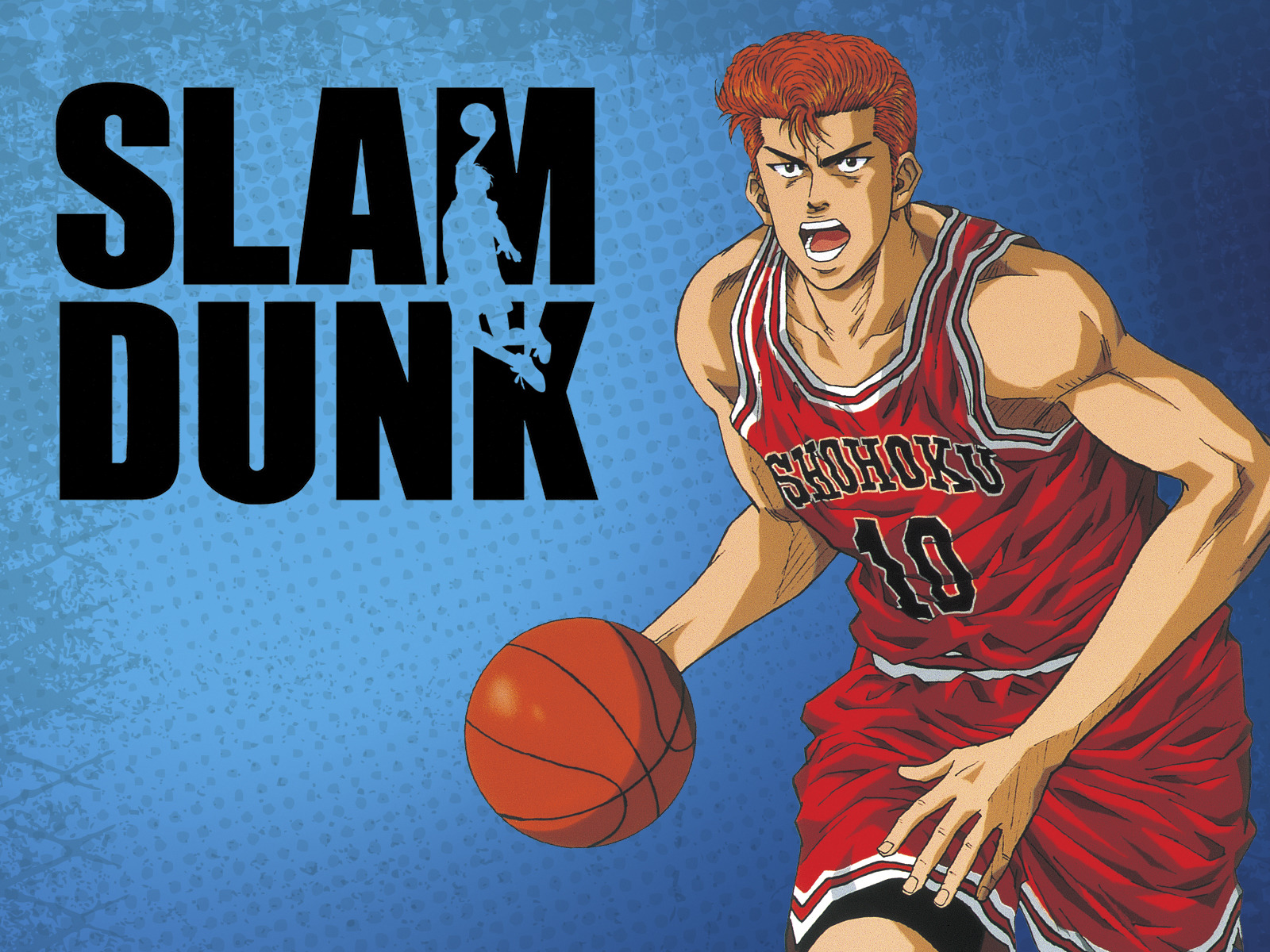
Hanamichi Sakuragi, known for his fiery temper, massive height, and flame-red hair, enrolls in Shohoku High, hoping to finally have a girlfriend after being rejected 50 times straight in middle school. He is avoided by most students, however, due to his notoriety. Hanamichi’s two unwavering thoughts after certain events are, “I hate basketball,” and “I desperately need a girlfriend.”
He is approached by a girl named Haruko Akagi without knowing anything about his troublemaking ways and asks him if he likes basketball. Hanamichi is instantly enamored with her, blurting out a fervent affirmative. After that, she takes him to the gymnasium and asks him to slam dunk.
Aiming to impress Haruko, he leaps and overshoots, instead of hitting his head on the blackboard. As Haruko informs the basketball team’s captain of Hanamichi’s near-inhuman physical abilities, he eventually finds himself drawn into the camaraderie and competition of a sport he had previously held resentment for.
The way the relationships develop in the story is one of the most touching aspects. Especially noteworthy is how loyal Sakuragi’s gang is to him so he can be part of the basketball team. While Sakuragi and his friends don’t have the best brains, they make up for it with their hearts, and that’s what makes this anime so great.
Even though Sakuragi starts playing basketball to impress a girl, you will be able to follow his progress and cheer for him just as you would for a friend starting something new. Despite having the genetics to excel in this sport, he still has a lot to learn, which may seem juvenile to those who are already familiar with the sport. However, you can sense his passion at the right time, and you hope he lives up to his potential.
Ping Pong the Animation
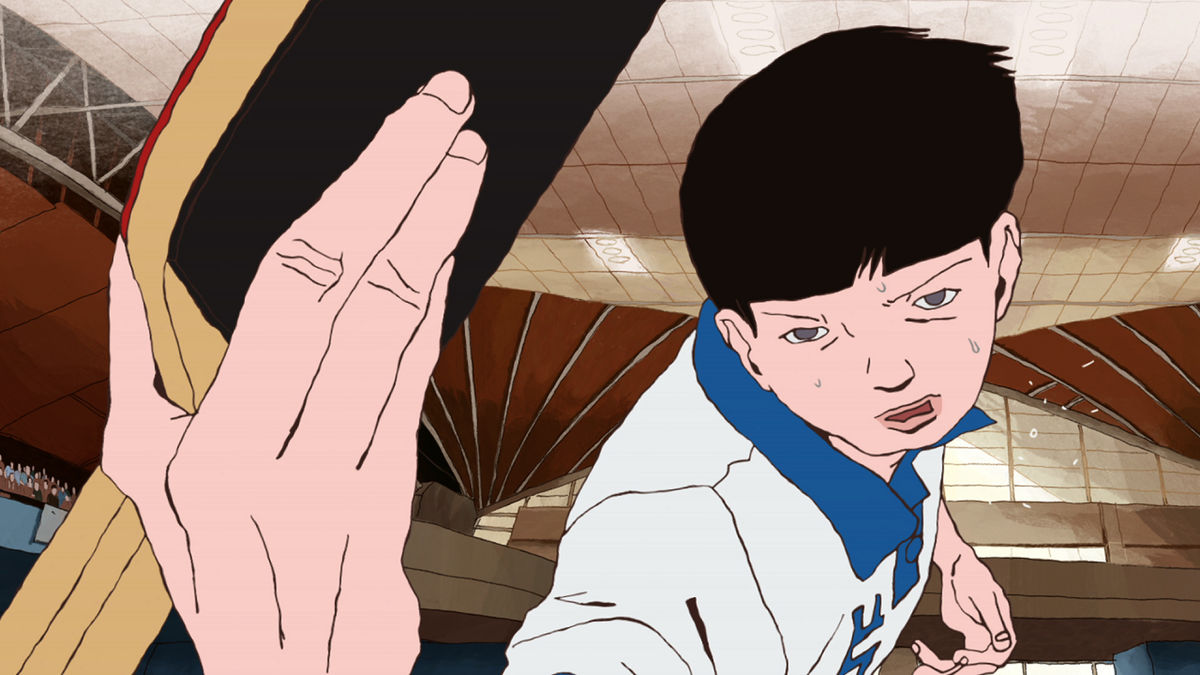
Makoto Tsukimoto repeats, “The hero comes. The hero comes. The hero comes. Chant these words in your mind, and I’ll surely come to you…” as a mantra and a source of motivation when fighting through stressful ping pong matches, as well as difficult situations in his everyday life.
Makoto fights with his friend, Yutaka Hoshino, nicknamed Smile and Peco, respectively. The two boys have been playing ping pong together nearly every day since they were children. Peco, full of confidence, aspires to become the best table tennis player in the world; Smile, on the other hand, shows little ambition. Their love for this sport has, however, kept them together, with a bond built on mutual respect.
Students from all over Japan compete to become national and international stars at the inter-high table tennis competition every year. However, only the best compete and succeed.
Ping Pong the Animation is a story of ambition with its fair share of bumps along the way. Despite all odds, Peco and Smile will face them together.
Ping Pong the Animation is a remarkable show. The series is less of a sports anime and more of an emotional one. The story is beautifully crafted and one that you don’t find very often. It is unconventional. Ping Pong doesn’t feel ordinary; it’s hard not to recognize its artistic merit.
Characters are what really make Ping Pong shine. The level of development in such a short time is impressive. Each interaction between characters seems natural and genuine. Even the most unlikely people grow, and this is a breath of fresh air from shows where nothing changes.
Kaze ga Tsuyoku Fuiteiru
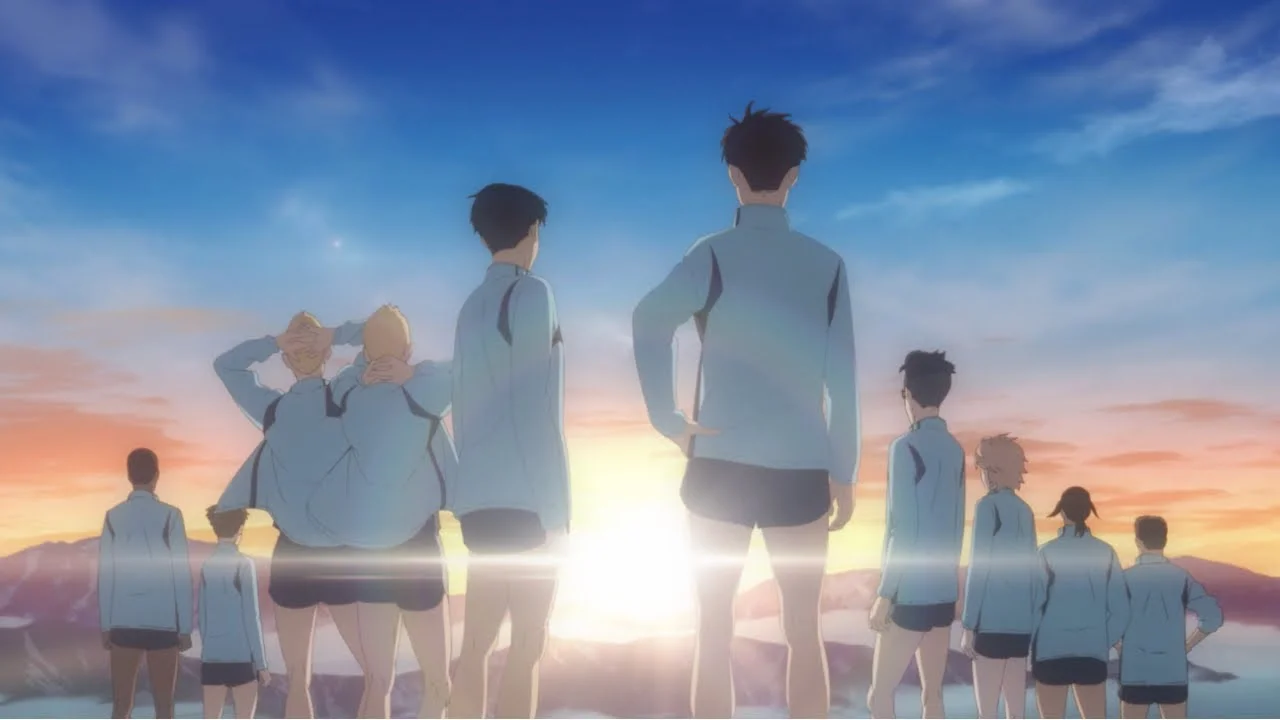
Kakeru Kurahara, a former ace runner at Sendai Josei High School, is chased away from a convenience store for shoplifting. He shakes off his pursuer and meets Haiji Kiyose, another student from his university. Kakeru’s agility impresses Haiji, who convinces him to live in Chikusei-sou, the run-down apartment where he lives with eight other students. Kakeru accepts the offer reluctantly after losing his entire apartment deposit at a mahjong parlor.
Haiji reveals a secret, however, during Kakeru’s welcome party: the apartment is actually the dormitory for the Kansei University Track Club. A prominent university relay race in Japan, Hakone Ekiden is one of his ultimate goals.
Sadly, all the residents are complete newcomers to running, except for Haiji and Kakeru. Even worse, none of the residents are even remotely interested in being involved with Haiji’s ridiculous plan!! Can the fourth-year student convince them otherwise just months before the deadline and realize his elusive dream of running in the Hakone Ekiden?
Kakeru begins to realize that he’s not alone and that he has friends to run with as the show progresses. Kakeru’s own journey has a major selling point in how he conquers his own demons and moves beyond his past.
While selling drama at every turn, this anime contains a lot of realism. With its insight into its characters, you’ll be able to experience a tale with its story that evokes emotions from the viewers. Do expect some lighthearted moments and comedy, despite how dramatic the show can be.
This anime manages to develop its character cast while staying consistent with the storytelling.
Cross Game
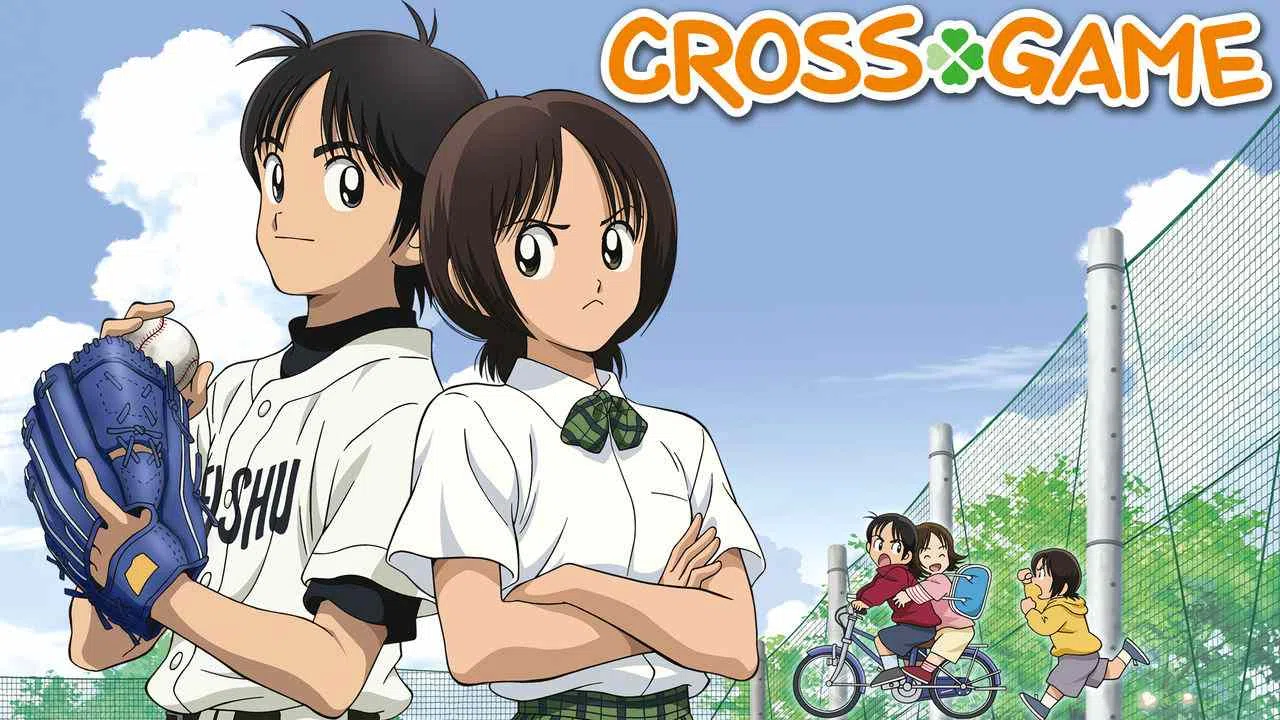
Despite the fact that their families are friends and business partners, Kou Kitamura and Aoba Tsukishima are frequently at odds. Despite being the only child of a sports shop owner, Kou has never shown any interest in baseball. Despite this, he has a strong batting ability thanks to frequent visits to the Tsukushima family’s local batting center. Aoba, on the other hand, is a star player who has exceptional pitching form.
Although these two seem to be complete opposites, Wakaba Tsukishima, Aoba’s older sister and Kou’s destined sweetheart, is very important to them both. She often finds herself a catalyst in their never-ending rivalry because she is revered by the quarrelsome duo.
Time will tell if they realize they have more in common than either would care to admit. Perhaps baseball will help them overcome their own personal struggles.
Throughout the series, there is tension and slow pacing. Cross Game is well-executed despite its somewhat predictable nature. The jokes are extremely well-timed and clever, even though they appear clichéd at times.
A juxtaposition of both serious and blithe is a tone not often seen in anime, but Cross Game nails it almost every time, making sure that the jokes are cracked just the right amount at the right time. The frivolity of their banter does not go unnoticed either. Every joke serves a purpose to enhance the emotional connection between the character and the audience.
The cast of Cross Game is one of the most memorable in all of anime. There aren’t really any characters that you won’t like because they are all developed so well. The main cast makes you sympathize with their struggles, hardships, and triumphs.
One Outs
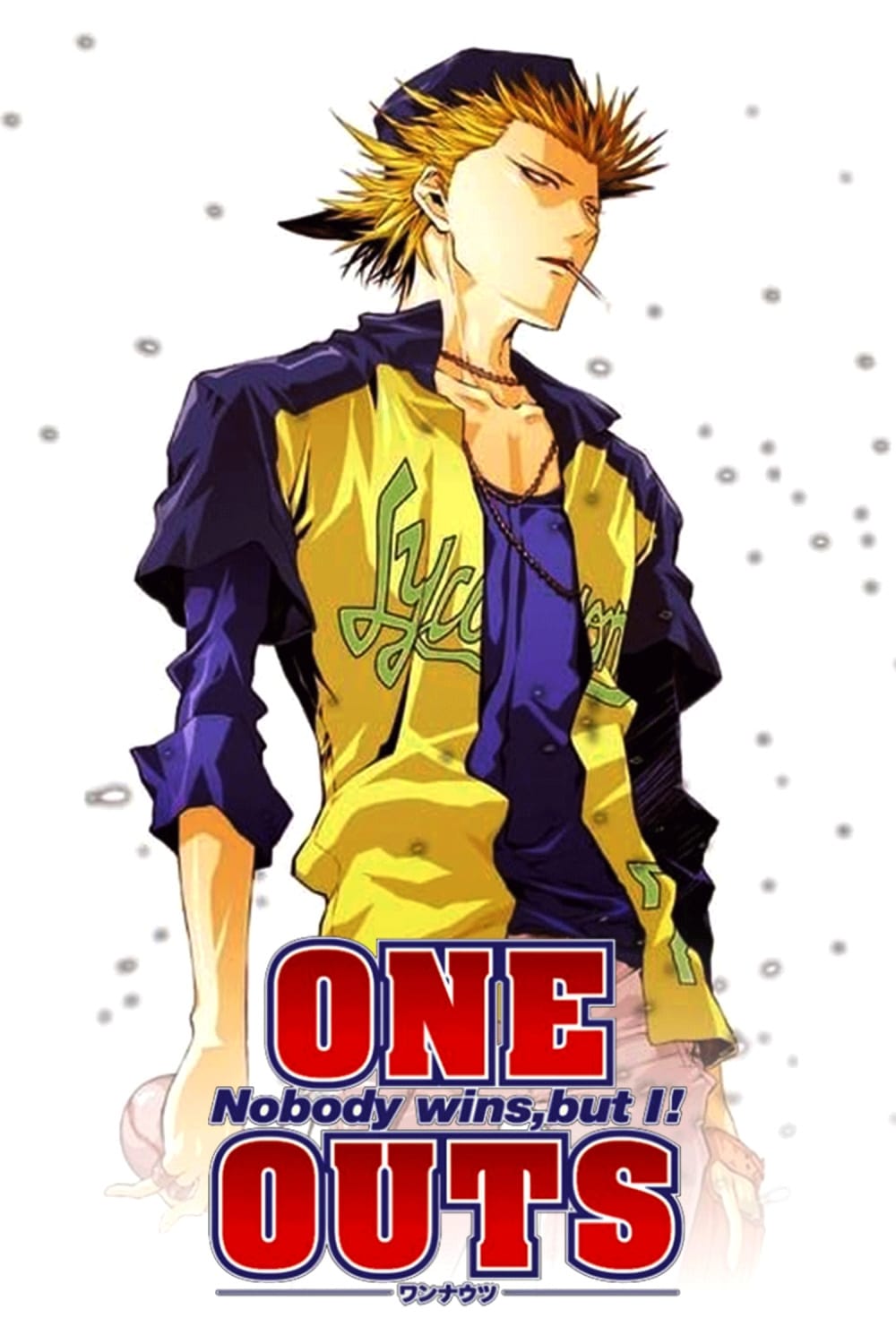
Toua Tokuchi is both a baseball and gambling prodigy. In a game called “One Out,” a one-on-one showdown between a pitcher and a batter, he has achieved 499 consecutive victories with only mediocre fastballs. Tokuchi, however, sees the sport as nothing more than a way to earn some quick cash.
As Hiromichi Kojima, a legendary hitter for the Saikyou Saitama Lycaons, witnesses Tokuchi’s skills, he realizes that Tokuchi might just be what the team needs to get out of their slump. Kojima determined to recruit Tokuchi no matter what puts his own career on the line to beat Tokuchi at his own specialty, One Out.
Tokuchi, after becoming a Lycaon, soon finds that he doesn’t get along with the team’s owner, Tsuneo Saikawa. Tokuchi proposes a special contract after Saikawa refuses to give him a reasonable salary: he’ll get five million yen if he pitches an out, but giving up a run will cost him fifty million. Each game has the potential to make or break him. Tokuchi must outwit those who oppose him, but will he succeed?
Each team has different methods for victory, from star players to expert strategies to outright cheating, and watching these methods be revealed, falter, and be destroyed by Tokuchi’s insights never gets old.
There’s everything a viewer could want in a series based on mentality and/or gambling, and baseball allows each episode to remain fresh due to how rules can be bent and loopholes exploited. If you are looking for a series revolving around plans, schemes, and overall mental acuity, you will not be disappointed.
Initial D First Stage
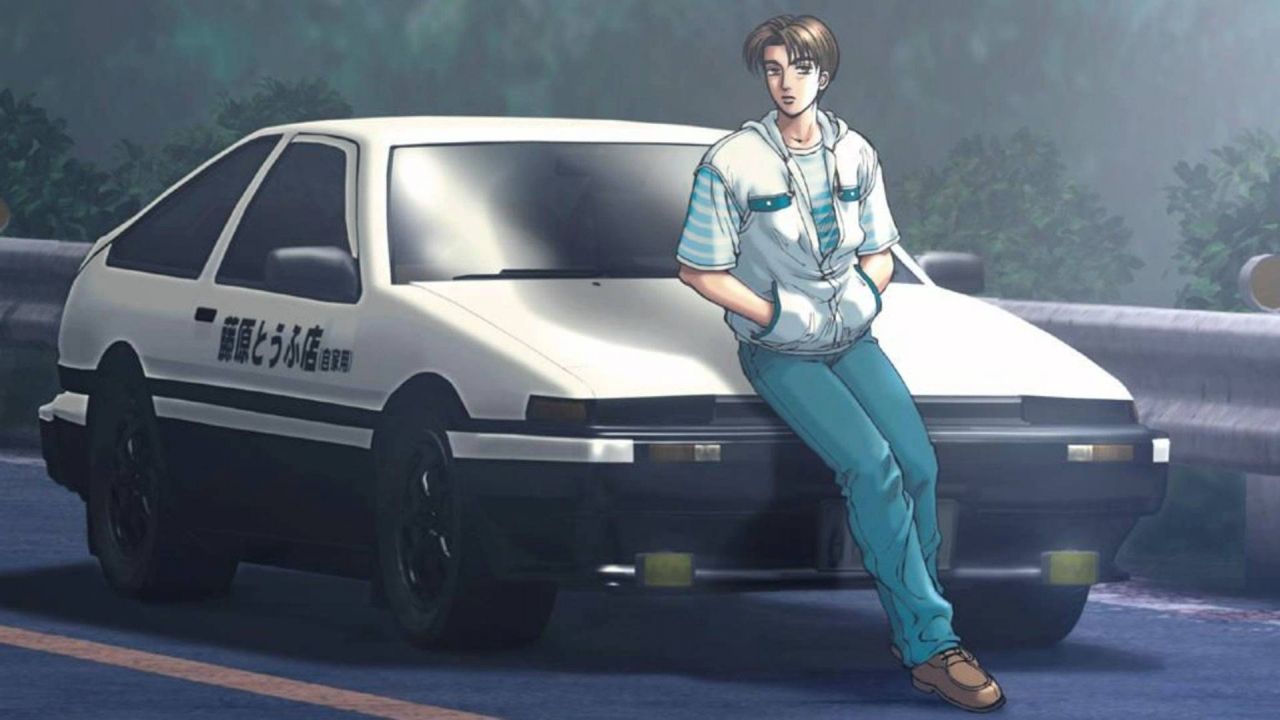
Takumi Fujiwara, in contrast to his friends, does not seem to be particularly interested in cars and has little or no knowledge about the world of car enthusiasts and street racers. His father is a tofu shop owner and is tasked with delivering tofu every morning along the mountain road of Akina. Talking about cars or driving, in general, would only serve to remind Takumi of his exhausting daily routine.
One night, the Akagi Red Suns, a famous street race team, visit the town of Akina to challenge its mountain pass. Their two ace drivers, Ryousuke and Keisuke Takahashi will lead the Red Suns to conquer every track in Kanto, establishing themselves as the fastest team in the region.
A Toyota AE86 overtakes one of their aces during a drive home from Akina, much to their disbelief. As a result of the incident, the Takahashi brothers are cautious of a mysterious driver armed with considerable technique and experience in the local roads — the AE86 of Mount Akina.
Characters are a strong point of this series. Takumi is not the typical main character of a driving series; in fact, his apathetic attitude sets him apart. Rather than being an overly energetic, loud protagonist, he is quite reserved but sharp. The characters all blend in perfectly, and their interactions are honest.
Even though they use a little bit of racing jargon, you are never further behind than the main character, which allows you to be fascinated by street racing while Takumi does so.
Through his attitude and experience, he lures you into an otherwise complicated and technical world of street racing.
Redline
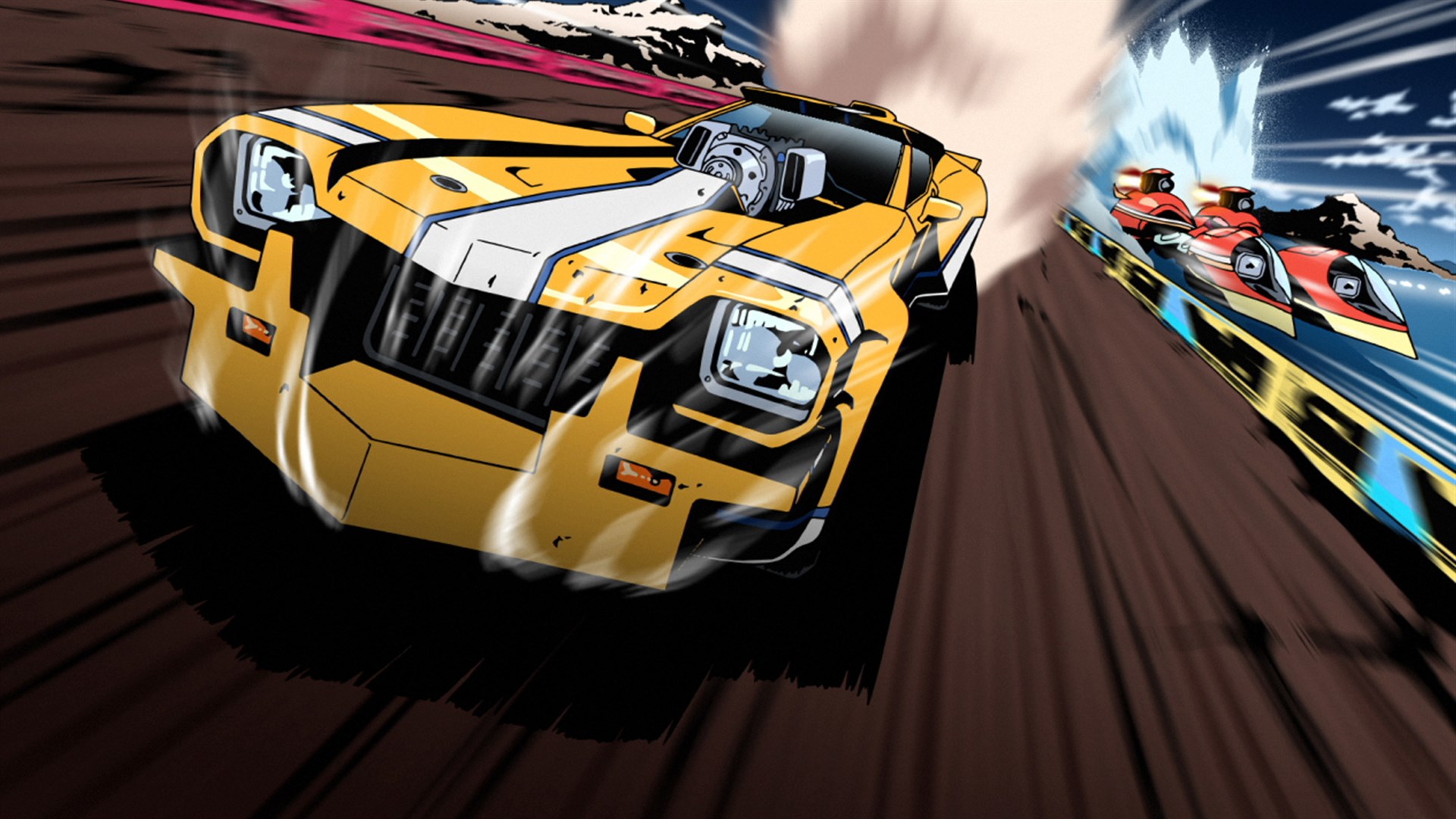
Redline is an exhilarating race held every five years, and the universe’s most anticipated competition has only one rule: there are none. During racing events, drivers are pushed to their absolute limits, a feeling that daredevil driver JP is all too familiar with.
Having just qualified to compete in Redline, he is eager to take on the other highly skilled competitors, especially the only other human who qualified, Sonoshee McLaren.
This year’s Redline, however, may be far more dangerous than usual — it has been announced that it will take place on the planet Roboworld with its trigger-happy military and criminals looking to use it to their advantage. The potential danger does not deter the racers; in fact, it only adds to the excitement. JP prepares to take first place in the biggest race of his life by relying only on the speed of his vehicle.
The plot of Redline is fairly standard fare for a film about racing, but the presentation of Redline is bigger than life, and the imagination and creativity that went into it is second to none. Despite cliches, the story is exhilarating and incredibly well-paced. As you would expect, the action is fast, exciting and full of adrenaline. Even though the drama has moments of cheesiness, it works well with the over-the-top attitude of the film.
The crazy antics in Redline prove that the film isn’t to be taken seriously; it isn’t a production intended to challenge our minds but rather an exhilarating thrill ride for our entertainment. The story delivers in that respect and then some.
All the main characters are conventional archetypes, but they aren’t made to be complex, deep, thoughtful beings. As with the story and presentation, the characters are themselves larger than life.
Major S1
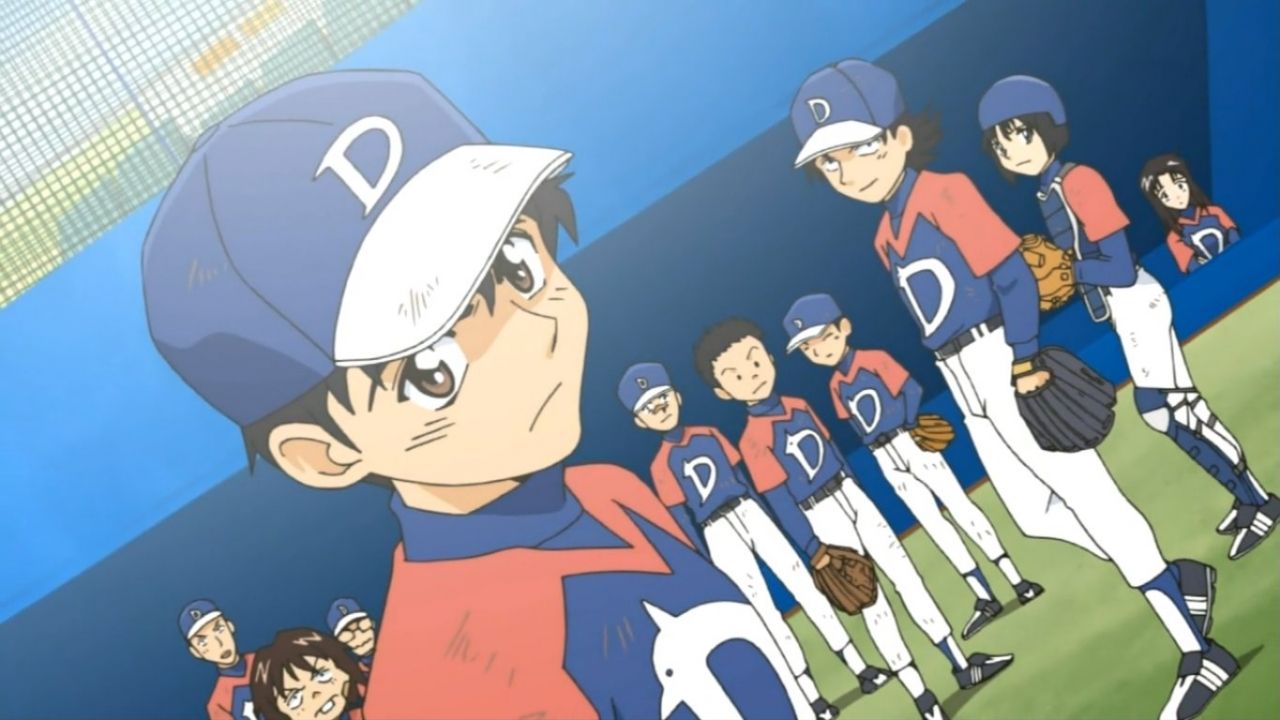
Gorou Honda, a young baseball enthusiast, has always admired his father, Shigeharu. Gorou dreams of following in his father’s footsteps and becoming a pro baseball player. In turn, his son’s adoration inspires Shigeharu to persevere, despite the death of his wife and his unsatisfying position on Blue Ocean’s second squad.
Shigeharu is unable to continue playing due to an elbow injury; he falls into despair as a consequence. As a result of an offhand joke from a childhood friend, Shigeharu reevaluates his choices and decides to stay in the game, leaving behind his position as a pitcher and taking up the bat instead. With a more determined attitude than ever, Gorou works hard to carve his way in the Japanese Little League. Gorou works hard to make his mark on the Japanese Little League now that he is more motivated than ever.
The story this anime follows is actually pretty typical, but it’s also got a lot of plot developments and drama thrown in, so don’t go in thinking this is just a tournament-after-tournament anime.
Among the noteworthy features of this anime is character development. As the series progresses, you’ll see the characters grow physically and mentally. Furthermore, it is very easy to get attached to the characters since they are all unique in their own way.
A team sport like baseball also places a lot of emphasis on the development of relationships within the team and how problems are resolved among each other. Each character is likable, and it’s fun to watch them interact with one another. The show also focuses on family quite moderately. There are a few issues that come up within Goro’s family, and it shows how he, as a child, handles them.
You should give this show a try because even if you don’t like baseball, the character relationships are enjoyable to watch regardless of the sport.
Ballroom e Youkoso
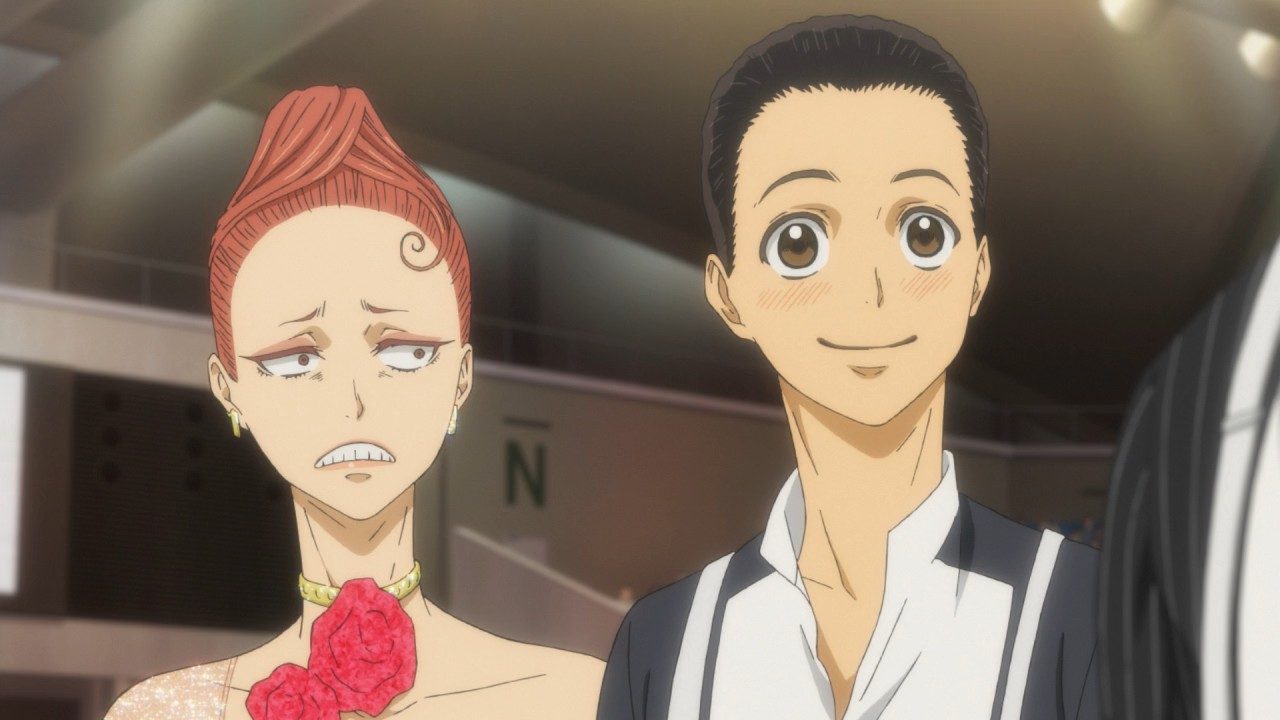
The shy Tatara Fujita of middle school has no particular plans for the future. He has survived life by avoiding confrontation and blending in with the crowd. As some bullies harass him for money, blending in won’t help him escape trouble. Fortunately, he is saved by Kaname Sengoku.
Tatara is invited to Kaname’s dance studio. Tatara is captivated by Sengoku’s commanding presence, despite the fact that he would normally never enter such a place. When Tatara has the chance to dance with fellow classmate Shizuku Hanaoka-who practices at the studio often-he realizes there’s something about being in the spotlight and dancing where people will see him that keeps him coming back.
Tatara begins his journey into competitive dance with an earnest, passionate desire to improve.
Watching Ballroom e Youkoso feels like taking a journey down memory lane. This is the kind of memory lane where you were once a kid and wanted to prove to everyone that you were talented.
In this anime, the central theme is ballroom dancing. Another anime about some championships or tournaments could also be similar to sports anime, but you could be wrong. Ballroom e Youkoso is an innovative adaptation that combines superb storytelling with stunning art design to enthrall viewers.
There are many layers to the story, though most of it still follows Tatara and his journey. In addition to dealing with personal problems, he establishes rivalries with certain characters he meets. In addition, an important part of this show involves him building relationships with others.
There are many characters in the adaptation. Of particular interest is the personality of the competing couples. Ballroom e Youkoso is a well-adapted anime that focuses on what it intends without betraying expectations.
Chihayafuru

Chihaya Ayase, an independent, tomboyish girl, grows up under the shadow of her sister. Till she meets Arata Wataya, she is content with her share in life, as she has no dreams of her own. She learns about competitive karuta from the quiet transfer student in her elementary school, a mentally and physically demanding card game inspired by the classic Japanese anthology Hundred Poets.
Arata’s passion for the game and the possibility of being the best in Japan inspire Chihaya to fall in love with karuta. With the prodigy Arata and her haughty buthard-working friend Taichi Mashima, she joins the local Shiranami Society. They spent their idyllic childhood days playing together before circumstances separated them.
Now in high school, Chihaya is a karuta freak. She plans to establish the Municipal Mizusawa High Competitive Karuta Club, aiming to compete at the national championships at Omi Jingu. As Chihaya reunites with the now indifferent Taichi, she is one step closer to realizing her dream of establishing a karuta team: she must assemble members who share the same passion for the sport.
This show is more than just card games. As seen through the eyes of Chihaya, the protagonist of the series, karuta is also about creating a dream for herself as well as about her bond with Arata and Taichi when she was 12 years old.
The story includes romance, but it is merely an element of development. More so than any romantic moment, the story is focused on the love of friendship and the game itself.
A show like Chihayafuru is primarily characterized by character-driven plots, which can in its own way produce heart-wrenching entertainment. Each of the characters has a characteristic to love, from their design to their personalities.
Diamond no Ace
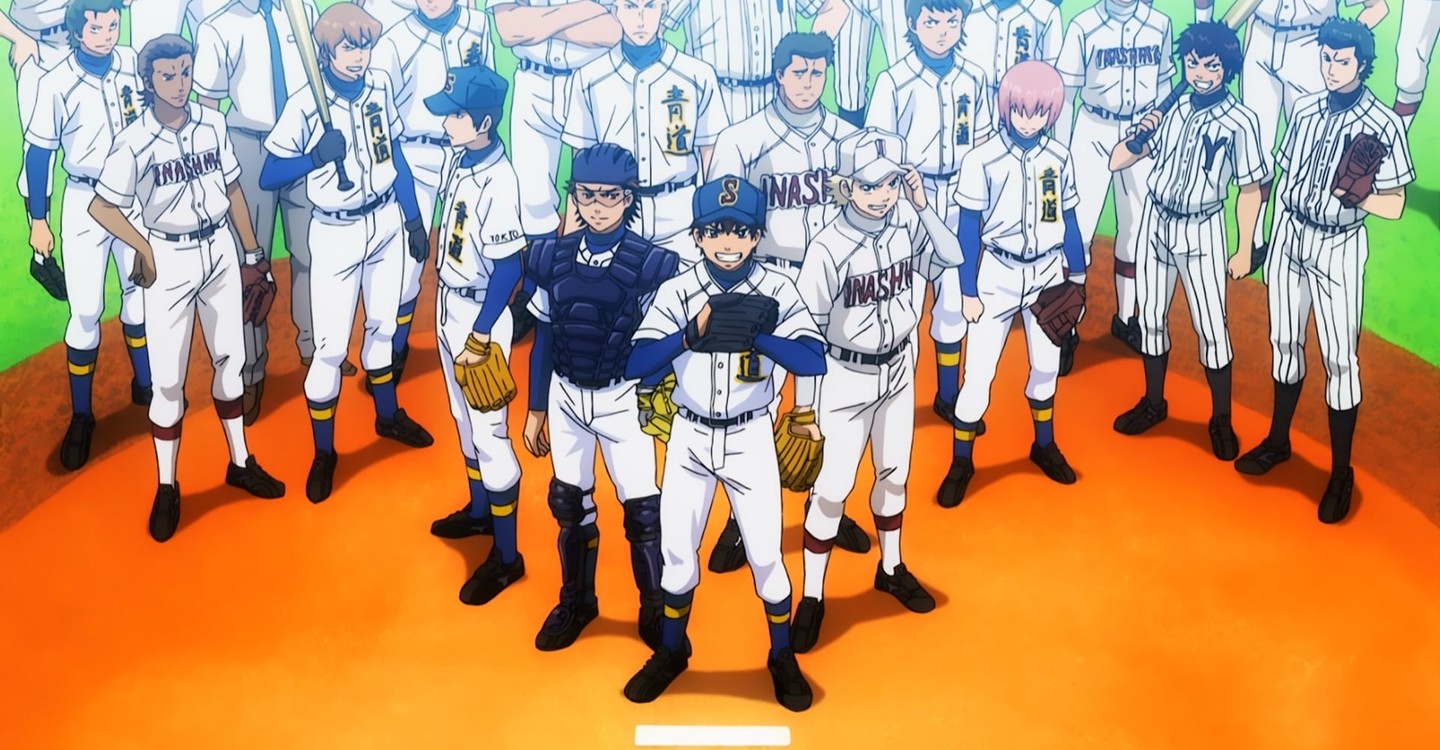
As a result of a stray pitch that completely missed the batter, Eijun Sawamura loses his final middle school baseball game. As a result of this defeat, Eijun and his teammates vow to make it to the national championship once they are in high school.
However, everything changes when a scout spots the potential in his unusual pitching style and unexpectedly invites him to Seidou High School in Tokyo. Eijun is encouraged by his teammates to accept the offer, eager to improve his skills and play at a much higher level of baseball.
However, with a large number of talented players on the team, Eijun has difficulty finding his place. He declares he will one day become the team’s ace, but only if Satoru Furuya doesn’t first take the title, with his breakneck fastballs that earn him a spot on the starting lineup.
By adding these talented players to an already potent lineup, the Seidou baseball team hopes to become the best in Japan, facing several formidable opponents along the way.
A major strength of Diamond no Ace is the variety of interesting characters and how much time is spent developing them in addition to the main character, Eijun Sawamura. Even though Eijun is the central character, he almost feels like a vessel that enables the viewer to see and interact with the other characters. The sport of baseball makes it necessary for a large number of characters to exist.
However, the side characters aren’t shown just for a brief glimpse in an episode and then are nowhere to be found the next. All the characters have some kind of development and unique trait to them that makes them all memorable.
SK∞
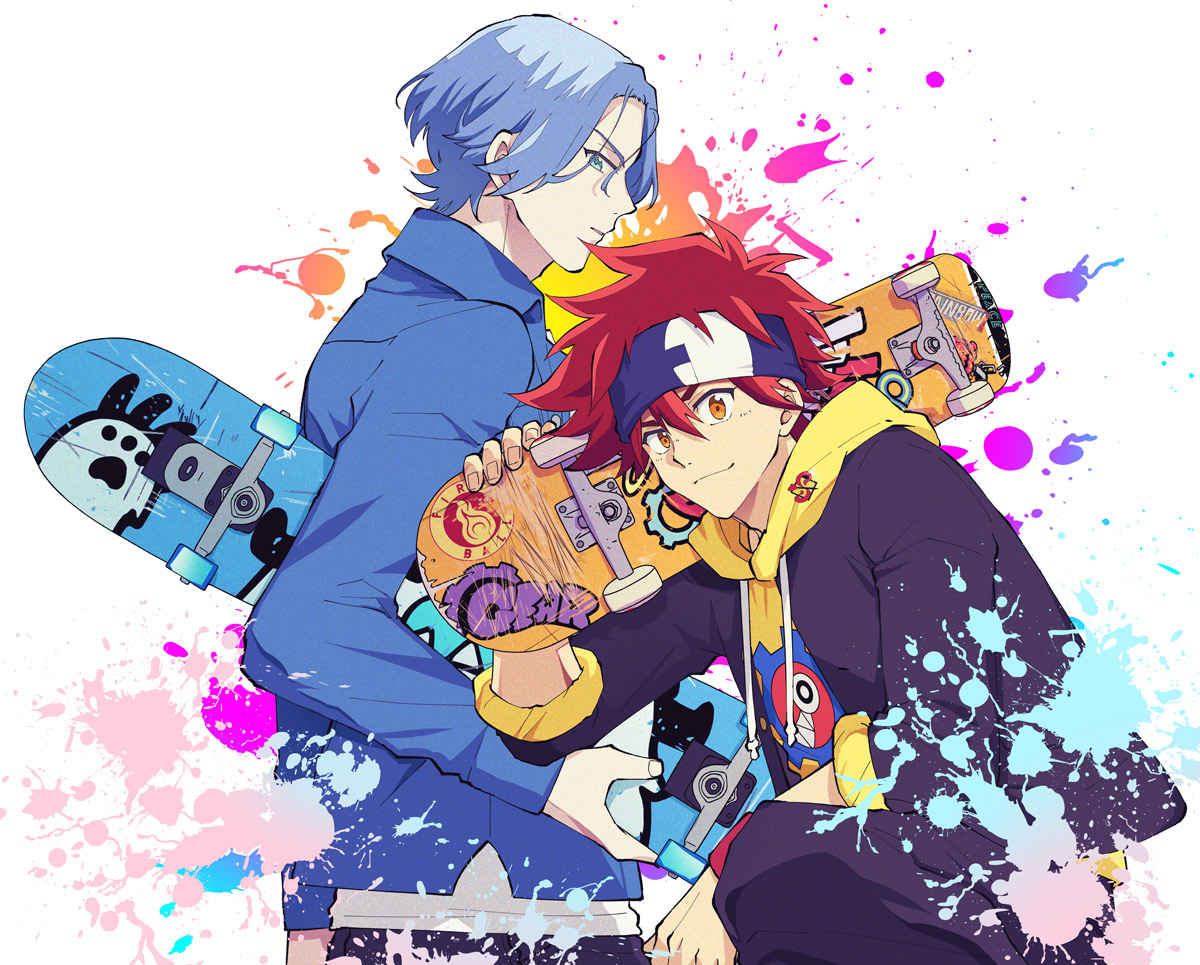
Student Reki Kyan loves skateboarding more than anything else. At night, he heads to “S,” an underground race inside a mine where skaters compete in highly dangerous situations. In the aftermath of a loss that results in his skateboard being destroyed and his arm being broken, Reki cannot practice at all.
Reki meets Langa Hasegawa, a half-Canadian, half-Japanese boy with no skateboarding experience while working. Langa is in pressing need of money. Both Langa and Reki visit “S” when Reki’s boss orders them to do so, but they get into trouble and are roped into a bet that requires Langa to skate in a race.
The mysterious transfer student, however, holds a trump card that Reki is unaware of, one which might lead him to victory in an unexpected manner.
With SK∞, the script has a casual tone that is easy to catch, as well as funny overtones that are effective without recurring. Obviously, it’s not based on reality. Skateboarding moves performed by characters often violate the laws of physics.
Though the show handles the skateboarding aspect of things in an over-the-top manner, it nails the realness of its character relationships. This show has great chemistry between its main cast. Like a real-life group of friends, they have their own inside jokes and habits.
The best episodes in this series feature the gang just hanging out and having fun. It feels real. Moreover, there is great character development for the two main leads as well as the majority of the cast. This is a show that’s fun to watch, and one thing that’s for sure is that you’ll have fun the entire time you’re watching this show.
Yowamushi Pedal
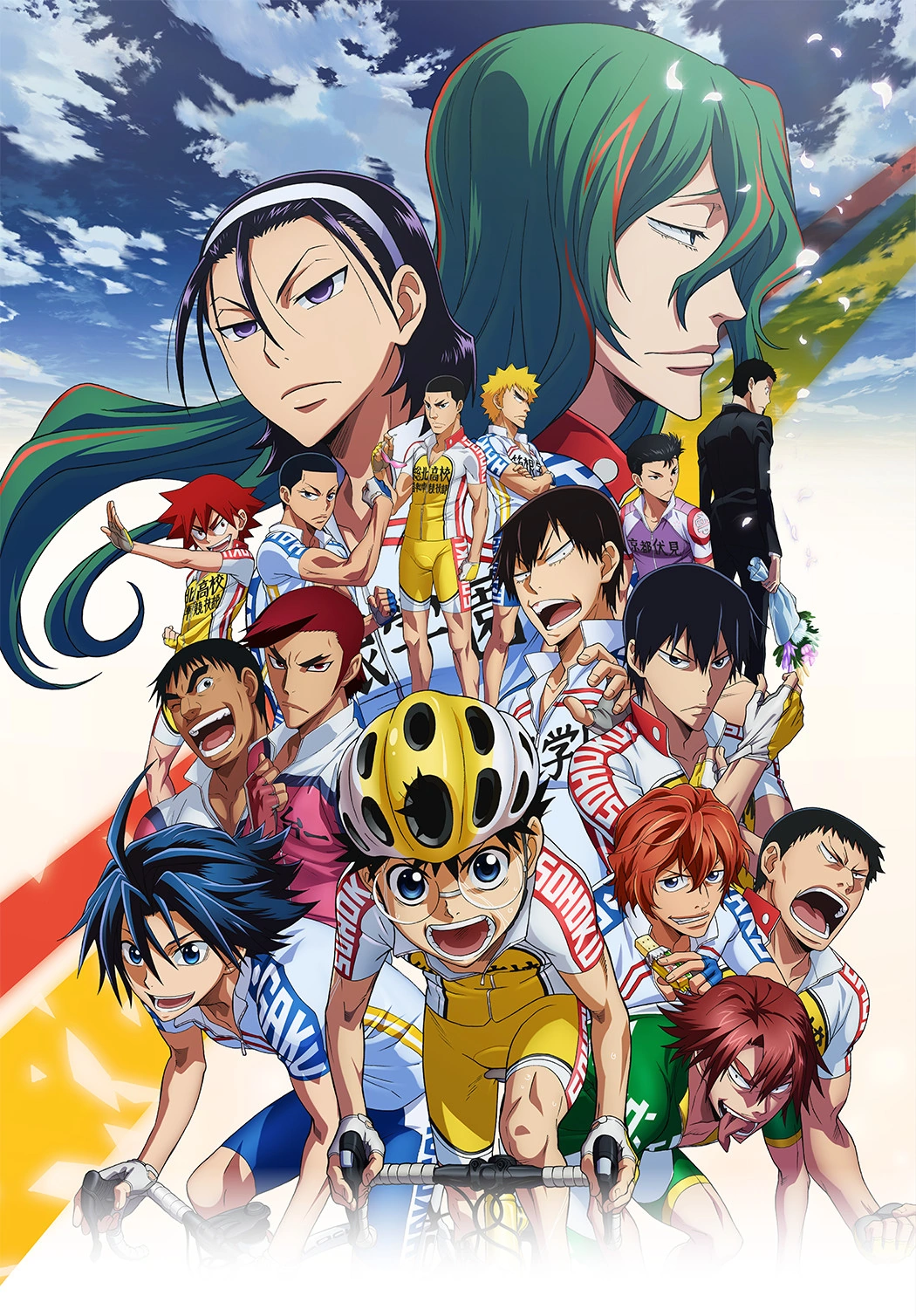
Sakamichi Onoda is a cheerful otaku, eager to make friends at his new school’s anime club. Sadly the club has been disbanded, and he takes it upon himself to revive it by finding students who are willing to join. Onoda attempts to make a round trip to Akihabara on his old, bulky city bicycle, a weekly 90-kilometer ride he has been taking since fourth grade, without much success.
As he practices on the steep incline, he meets fellow first-year student Shunsuke Imaizumi, a determined cyclist. Astonished by Onoda’s ability to climb the hill with his bicycle, Imaizumi challenges him to a race, offering him a place in the anime club if he wins. Here begins the young boy’s first foray into the world of high school bicycle racing!
As opposed to most sports anime protagonists, Onoda is not a hot-blooded maniac obsessed with winning. Onoda is timid, weak, but earnest. He pedals on not because he is proud but because the aching muscles and wind pounding against him makes him feel alive.
Yowamushi Pedal does an excellent job of making cycling accessible to those without prior experience or interest. Basic terminology is conveyed to the viewer without being condescending, and the focus is more on the abilities of the cyclists than the intricacies of some obscure technique.
Yowamushi Pedal is, above all, an inspirational story of the weak beating the odds and triumphing over the strong. It won’t leave you with anything you haven’t seen before, and while it may not leave you with anything deep or philosophical, it excels at what matters most: leaving the viewer with a smile on their face.
Eyeshield 21
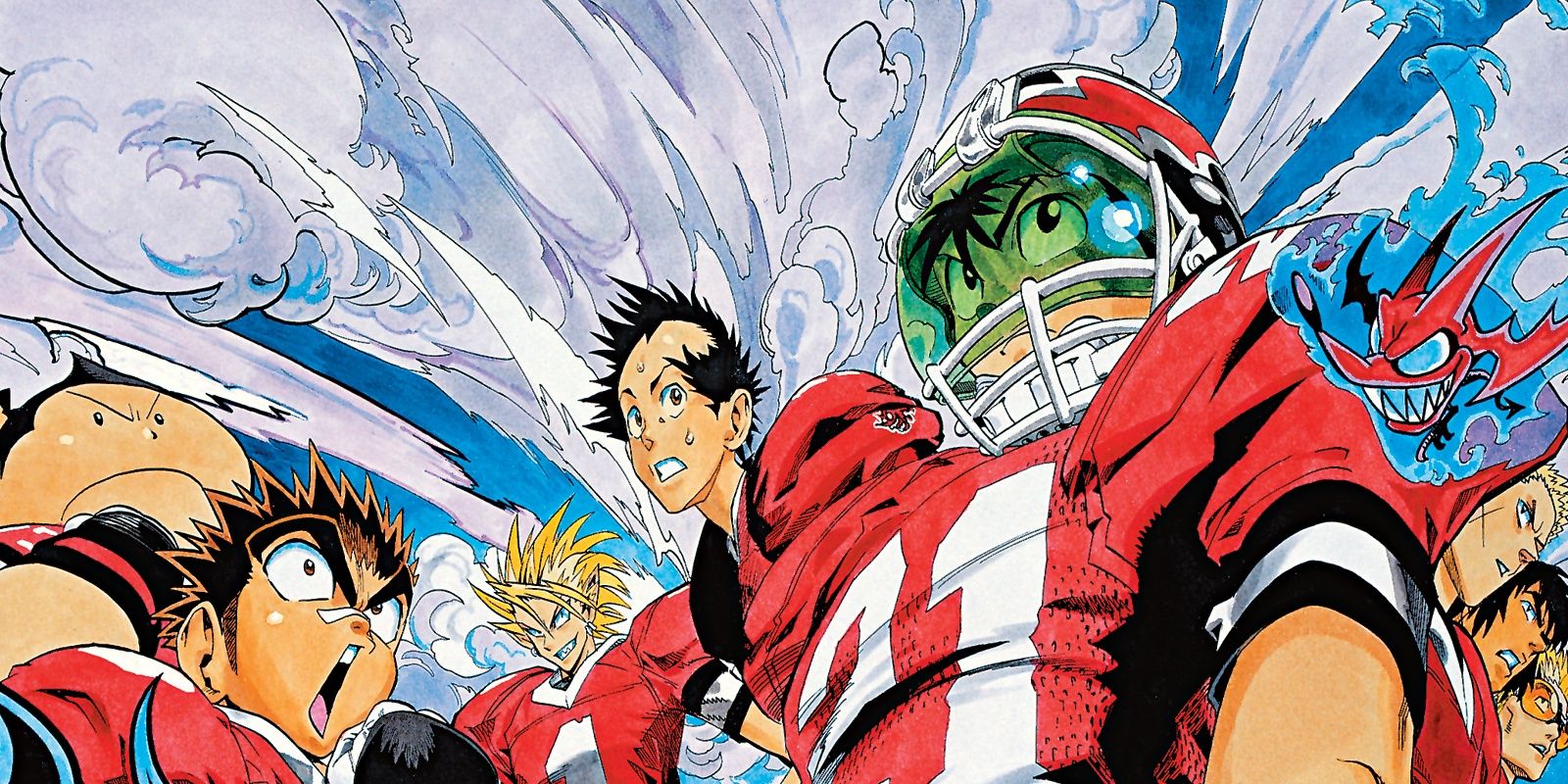
Sena is like any other shy student starting high school; he’s just trying to get by. Bullied constantly, he is used to running away.
When Hiruma, the school’s American football captain, witnesses Sena’s amazing agility and speed during an escape from bullies, Hiruma’s high school survival is going to get a whole lot more difficult. To turn the squad around from being the laughingstock of Japan’s high school leagues to a title contender, Hiruma schemes to make Sena the running back of his school team, The Devil Bats.
Sena is hired as the team’s “team secretary” in order to protect his star player from rival recruiters. Sena is given a visored helmet and the nickname “Eyeshield 21” so that his identity will be hidden.
“Eyeshield 21” will lead the Devilbats to the Christmas Bowl, which is attended by the best football teams in Japan every year. Can they win the Christmas Bowl? Can Sena become an all-star player from a timid, undersized freshman? Don your pads and helmet to find out!
Eyeshield’s cast is anything but bland when it comes to characters. From Sena’s traditional shounen perseverance to Hiruma’s demonic avarice, Eyeshield 21 does a masterful job of designing characters to both appeal to viewers and to transition their interactions with each other smoothly.
In the midst of drama and football action is raucous comedy that borders on the absurd yet is still incredibly funny. In reality, when watching a sports series, you are more interested in the character development and the anime action than the plot. Watching Eyeshield 21 is hilarious, action-packed, and a touchdown.
Kaleido Star
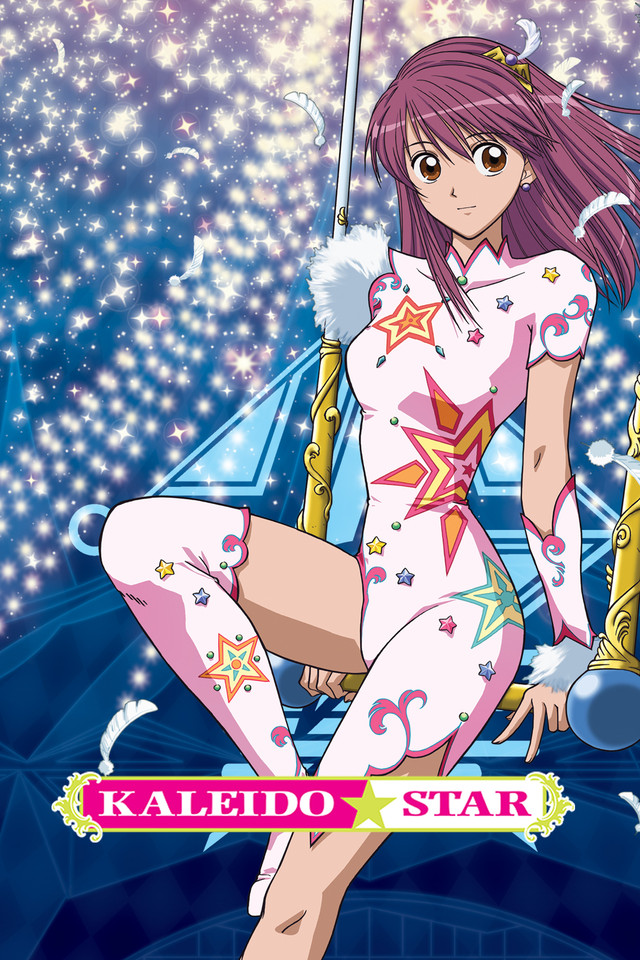
Throughout the world, the Kaleido Stage’s amazing acrobatics, inventive routines, and elaborate costumes captivate audiences. Sora Naegino only wants to become an acrobat for the famed circus. People come here to believe in magic, and she wants nothing more than to be a part of that magic.
She journeys from Japan to California to audition for a place in the group. Sora learns, however, that she needs more than her natural talent to make the crowd smile. She soon realizes how difficult it is to be a professional performer, where the stakes-and the stunts-are higher and mistakes can be deadly!
Performers on the Kaleido Stage undergo rigorous training, unconventional assignments, fierce competition, and the antics of a mischievous spirit named Fool.
To become a Kaleido Star, can Sora reach new heights, make new friends, overcome her fears, and surpass her limits?
As an overall concept, the story is not very special since it’s just about a girl trying to achieve her dream and facing many hardships along the way. However, the idea of a circus with acrobats is unique. In anime, it’s rare to find a series that tackles this genre and keeps it so interesting and magical.
This is a good show that focuses on friendship, mainly because Sora receives a lot of help from the people around her. It’s not just a one-girl show; all of them stand out as well. Any of the characters is impossible to dislike since even the bad ones turn out to be good in the end. This is an idealistic approach, but it leaves you with a warm fuzzy feeling at the end.
Yuri!!! on Ice
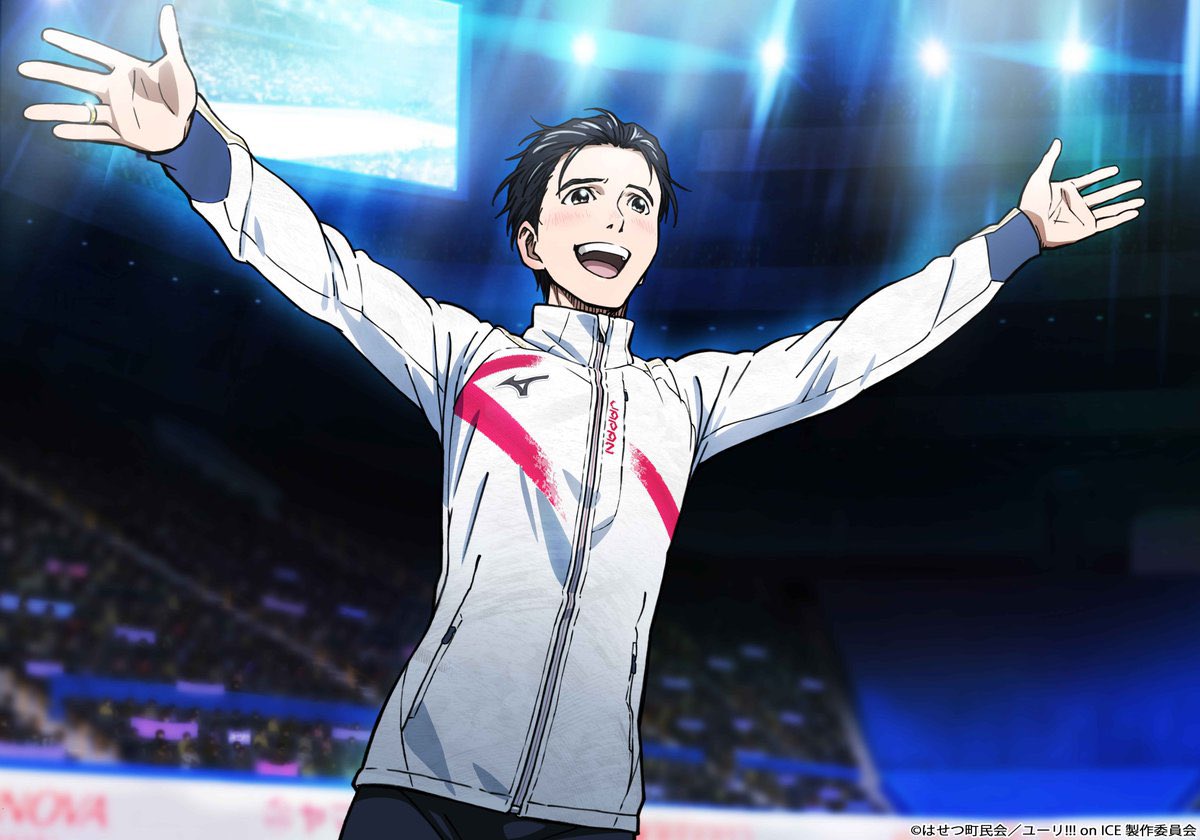
Yuuri Katsuki, once Japan’s top figure skater, returns home to assess his options after suffering a crushing defeat at the Grand Prix Finale. As a 23-year-old, Yuuri’s window for success in skating is closing rapidly. Additionally, his love of pork cutlets and tendency to gain weight is not helping either.
Yuuri, however, finds himself in the spotlight when a video shows him performing a move previously executed by Victor Nikiforov, the five-time world champion. Yuuri is astonished when Victor himself appears and offers to be Yuuri’s mentor. Yuuri, one of his biggest fans, eagerly accepts, starting his journey to return to the world stage. Meanwhile, the rising star from Russia, Yuri Plisetsky, is relentlessly determined to beat Yuuri and win back Victor’s tutelage.
There is a competitive sports atmosphere in the show, but every so often, the audience will notice character relationships. At times, they can be fierce. At the show’s core are Yuri and Victor.
The way it takes advantage of the competition, characters, visual dynamics, themes, and directing is worth every second. The pacing is also quite good since it doesn’t waste too much time getting to the point. The comedy is straightforward as well, and although it can be a bit awkward at times, it still delivers with the character chemistry and the reactions of the characters. Retrospectively, it’s a show that is here to entertain.
As well as having their own unique style, each skater also shows their personality with their performances. Aside from the strong production quality, the show also has a great set and character designs. There is something exceptionally phenomenal about ice skating and the relationship between the characters in this anime.
Free!
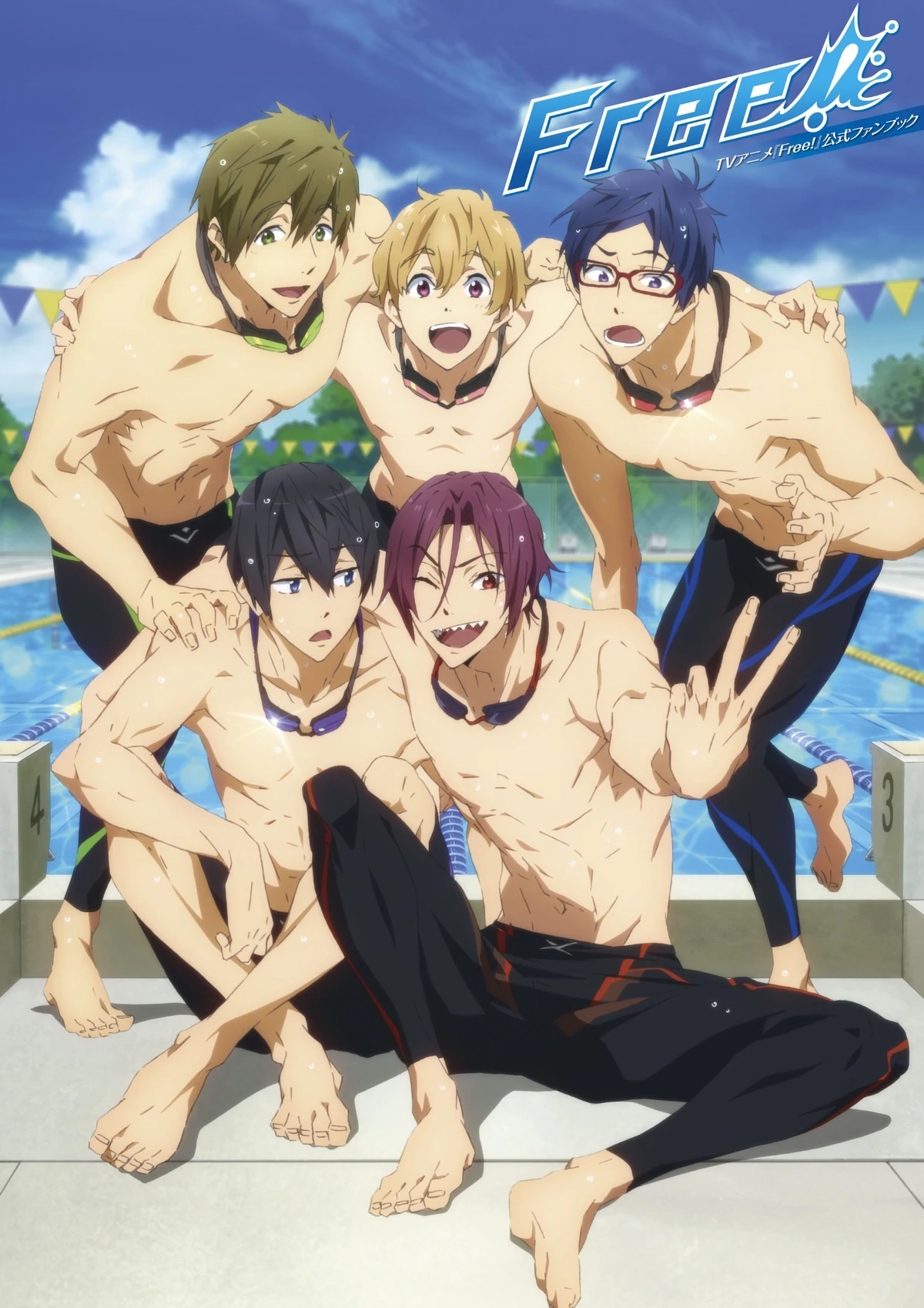
Haruka Nanase loves the water and enjoys swimming. He participated in a relay race and won it with his three friends Rin Matsuoka, Nagisa Hazuki, and Makoto Tachibana, while he was in elementary school. The four friends split up after winning the tournament.
Rin doesn’t care about returning to the way things used to be when they reunite as high school students. In addition to attending a different school, he is obsessed with proving that he is a better swimmer than Haruka.
Haruka, Nagisa, and Makoto agree to form the Iwatobi High School Swim Club after a bitter reunion. However, if they want to participate in the upcoming tournament, they need a fourth member. In comes Rei Ryuugazaki, a former track team member that Nagisa recruits. While training diligently to come out on top and resolve things between Haruka and Rin once and for all, the four become close friends as the competition approaches.
While there isn’t anything spectacular about the spot, it’s refreshing; it’s about friendship and loyalty, being able to move forward with the help of others, and having faith in yourself instead of living a lie. There is something beautiful about this series: the idea of true friendship and how friends stay together forever the intricate characterization, and the almost perfect art and sound.
An important aspect of this anime is the emotional side; a lot of the story is told through loaded gestures and hidden meanings. These elements make an otherwise simple story quite interesting.
Despite the predictability of the characters, the development compensates. Characters evolve together, and if you compare the first episode to the last, you’ll easily realize that.
Megalo Box
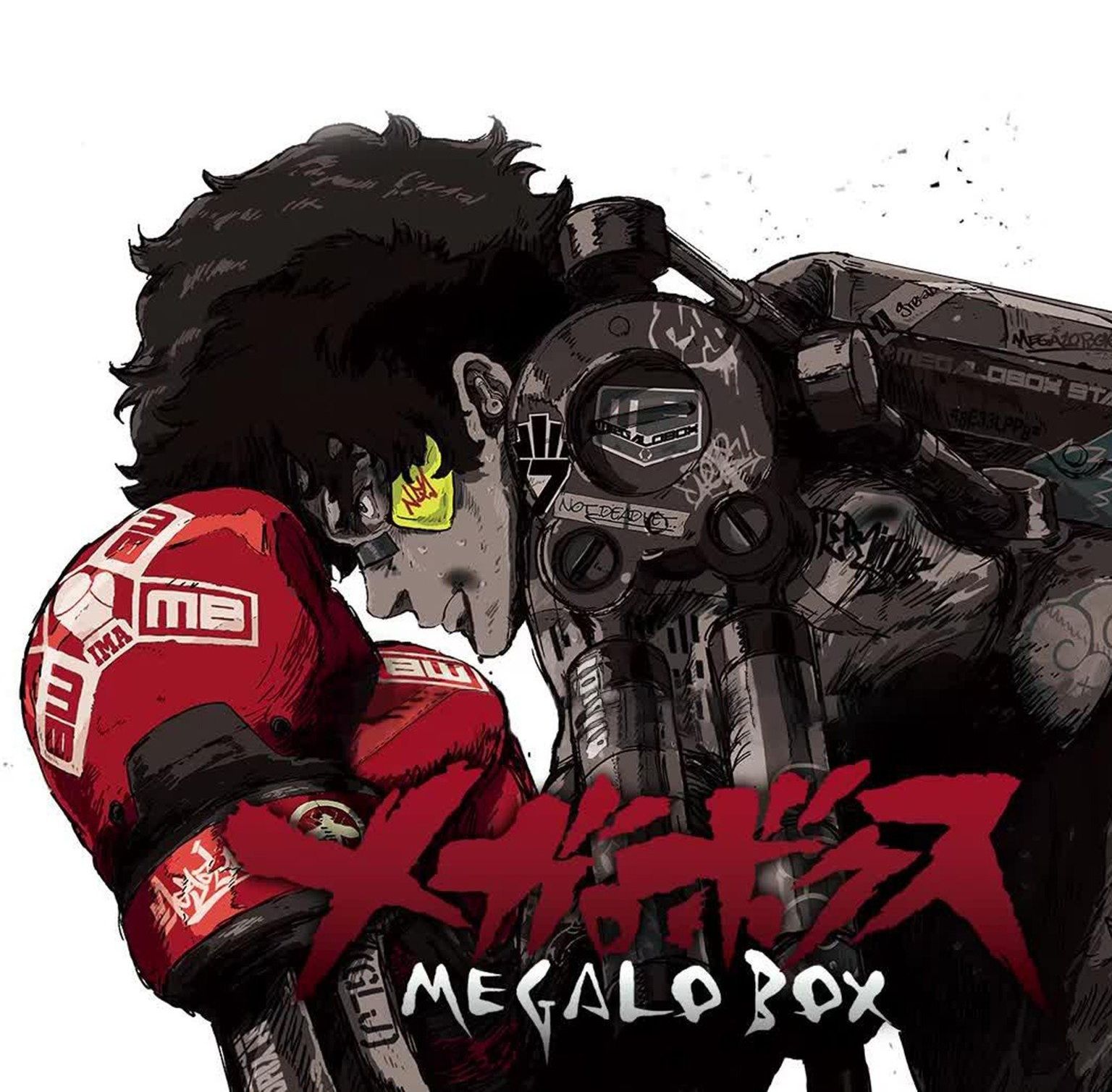
Junk Dog, an underground fighter in Megalo Box, a style of boxing that employs mechanical limbs called Gear to enhance a fighter’s speed and strength, says, “To be quiet and do as you’re told, that’s the cowardly choice.” Despite the young man’s promising boxing career, the illegal nature of his participation forces him to throw matches in order to earn a living as dictated by Gansaku Nanbu.
This all changes, however, when the Megalo Box champion Yuuri enters his shabby ring as just another challenger. Having been knocked out in one round, Junk Dog is offered a proposal: “If you’re serious about fighting me again, then fight your way up to me and my ring.”
With tremendous excitement and backed by the criminal syndicate behind his thrown matches, Junk Dog enters Megalonia: a world-spanning tournament that will determine which Megalo Boxer is the strongest. He does not have a name, so he takes on the moniker “Joe” as he begins his climb up the rankings.
Joe has only three months left to qualify, so he must face opponents that he has never faced before in order to meet the challenge of his opponent.
In Megalo Box, the characters are the best part. It doesn’t have many characters, but the few that are shown are well developed. The characters have conflicts of individual interests and interact in a very unpredictable way that makes them go beyond good and bad guys. In Megalo Box, it’s not about the individual fights – albeit being gorgeous and incredibly choreographed. It’s about the path to the top, and everything in this anime aids this single purpose.
Tennis no Ouji-sama

Prodigy tennis player Ryouma Echizen has returned from America at his father’s request and is ready to dominate the Japanese tennis scene. He enrolls at Seishun Academy, one of the top middle school tennis teams in Japan, with the intention of establishing himself as the best tennis player in the country.
Despite only being a freshman, Ryouma finds himself playing for a starting spot in the intra-school ranking matches after catching the captain’s eye. His age initially makes the rest of the Seishun Boys’ Tennis Team reluctant to accept him, but his skill and determination persuade them to accept him.
With the help of their new “super rookie,” Seishun hopes to secure a spot in the National Tournament. To qualify, the team must play in the Tokyo Prefectural and Kanto Regionals.
They are facing a road that is shared by a variety of strong schools, each playing tennis differently for different reasons. If Ryouma and his teammates want to become champions, they must learn how to cooperate.
Sport animes, in particular, require characters and unique personalities in order to be amazing. And this anime doesn’t disappoint. There are so many memorable characters in this show that you will have a hard time picking one out of the bunch because they are all so incredible.
Moreover, each of the characters is given a unique way of playing tennis by the creators. You’d think they would have to repeat somewhere with all the characters and opponents they present. But that’s definitely not the case.
Inazuma Eleven
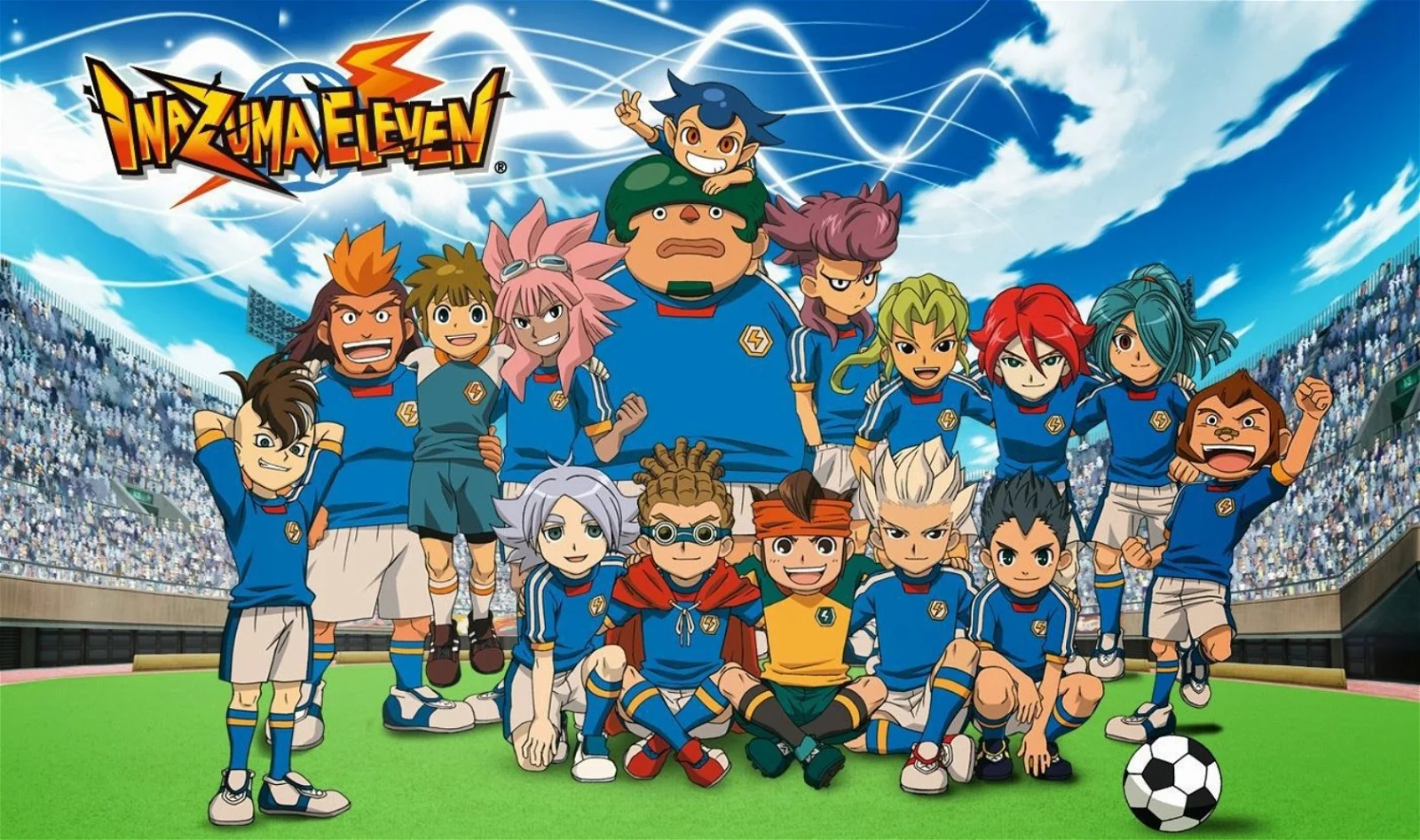
Inazuma Eleven, the soccer club at Raimon Middle School, is on the verge of disbanding while other schools compete for the title of Japan’s best soccer club. Mamoru Endou, the grandson of the club’s first generation goalkeeper and captain of the team, is determined to strengthen the club after it has been neglected for too long. He needs a little help and more than a little luck to accomplish this.
Shuuya Gouenji, a brilliant young soccer player who has given up on the sport, gives Mamoru Endou hope. No matter what it takes, Mamoru is determined to get Shuuya and other new recruits to join his team. Will his passion and determination be enough to save the club? Or is there no more hope for the team?
Inazuma Eleven is focused on the characters, which are well designed and unique. There is character development, and even though there are a lot of characters, the show manages to balance quantity and quality. Every character has a unique story and challenges. The characters play a crucial role in the series, as in any anime, and they all have their own unique personalities, and the relationships among them are strong.
Some of the amazing supernatural techniques, ranging from fire tornadoes to ghost hands, are so amazing that you want to try them out in real life. It’s nice to cheer along with the crowd when the main characters score, but it’s also sad when they lose. Simply one of the most enjoyable animes. In case you are looking for a great sports anime that is entertaining and has great characters, this is definitely an anime that is recommended.
Baby Steps
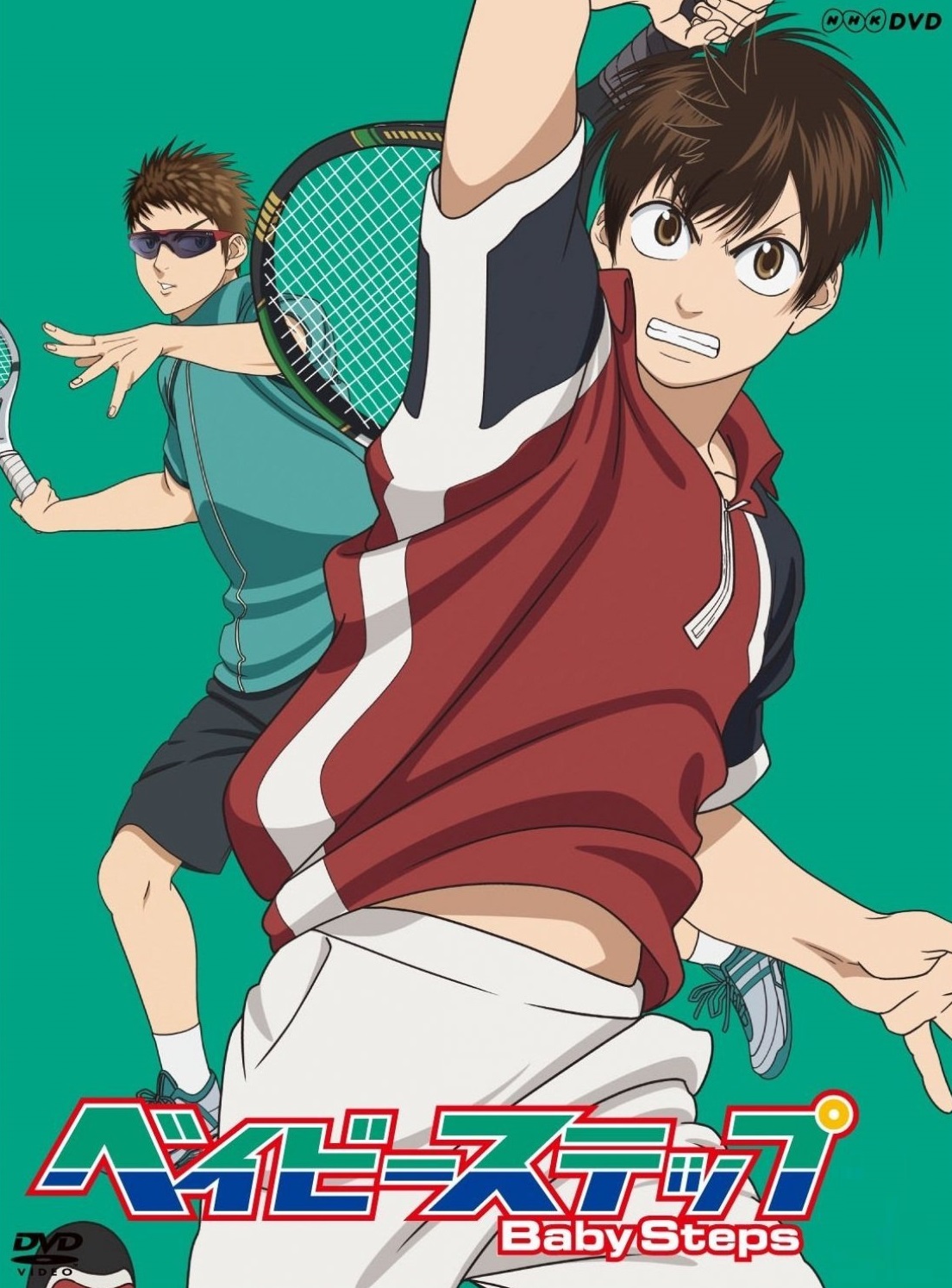
Eiichiro Maruo, an honor student who is diligent and methodical, decides to exercise more during his little free time because he is concerned about his health. At the beginning of his freshman year, he joins the Southern Tennis Club after seeing a flyer.
In a free trial at the club, he meets Natsu Takasaki, another first-year student who wants to become a professional tennis player due to her love of the game. Eiichirou, on the other hand, lives a study-oriented life because he believes that it is what he must do and not because he enjoys it. His monotonous days are halted though, as he becomes more fascinated by tennis as he plays more.
Baby Steps tells the story of a boy who uses his hardworking nature and perfectionist nature to develop his own unique style. As Eiichirou’s skills improve, he hopes to compete on an equal footing with tennis’ best players.
In Baby Steps, it is less about showing off the thrill of a match and more about what lessons can be learned from each one. But don’t be fooled; the matches are exciting! Maruo adapts to each situation with tons of thought throughout Baby Steps, demonstrating that tennis is a dynamic sport involving tons of mind games and research.
It is essential to like the main character in order to enjoy this show. Fortunately, Maruo isn’t too difficult to like. Despite his generic looks, he is pleasant, easily relatable, and makes a good impression. The keyword is relatable: this shounen protagonist does not need to be idolized. He’s just a person you might know in real life.
Tsurune: Kazemai Koukou Kyuudoubu
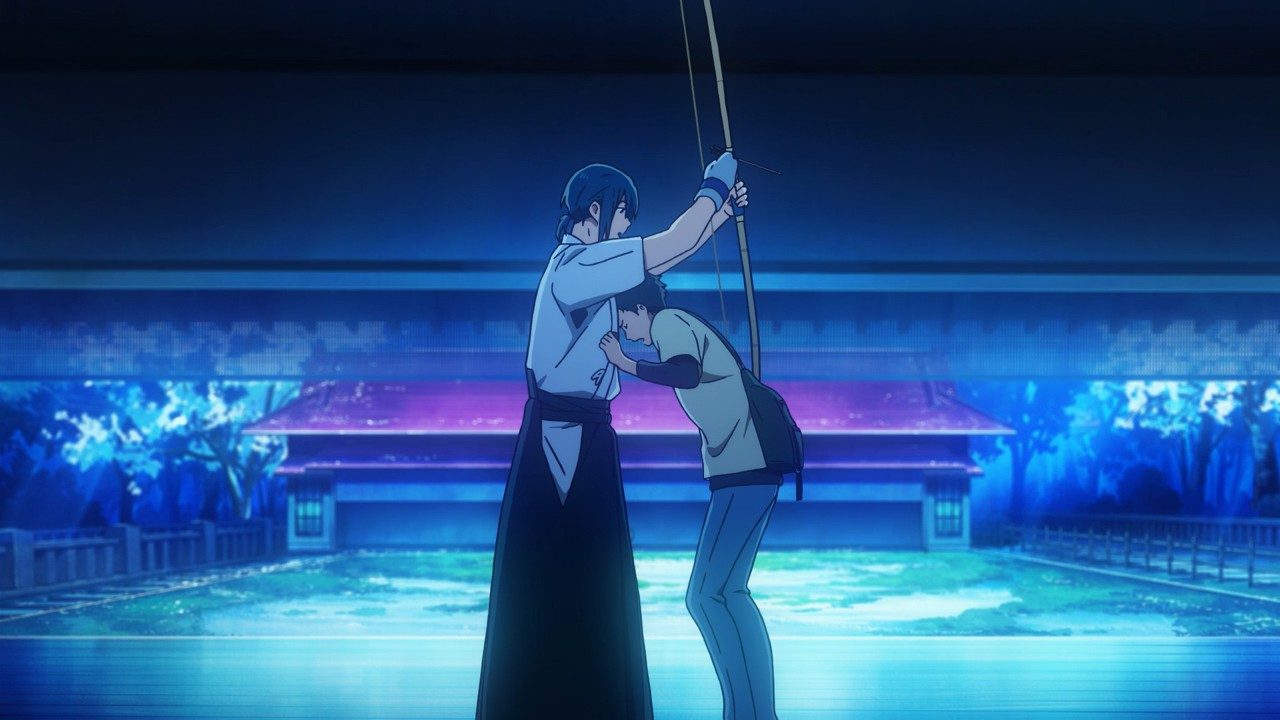
“Tsurune” – The sound a bowstring makes when an arrow is released, and the sound that inspired Minato Narumiya to learn Kyuudo, Japanese martial art that focuses on archery. However, he had to quit the sport after an incident during his last middle school tournament.
Soon, however, many factors conspire to encourage Minato to take up the bow once again: the launch of a new Kyuudo club in his high school, a chance encounter with an archer, and the encouragement of his childhood friends, Seiya Takehaya and Ryouhei Yamanouchi. Having rekindled his love of Kyuudo with his childhood friends and teammates Kaito Onogi and Nanao Kisaragi, Minato works hard with his team toward their aim of winning the prefectural tournament.
Tsurune’s themes are not new, but the way it portrays them is. “Are adults actually mature?” or “Do you love the sport?” are simplistic questions with a wide array of answers, and Tsurune can’t fully answer them either, but the dialogue used to address the questions has a certain charm to it. This is an intimate tale of patience and perspective, and this quality is precisely what sets it apart from within the genre.
When it comes to anime about sports, most of them focus on heavy amounts of drama and almost unrealistic situations, but Tsurune has just the right amount of drama. And, the story pulls you in and leaves you wanting more, even after the anime is over.
In a character-driven narrative such as Tsurune, the characters are undeniably the backbone of the entire show. The characters are very well-developed, and even though not every character is given substantial screentime or opportunity for development, the dynamic of the main cast is incredibly charming and down-to-earth.
Bakuten!!
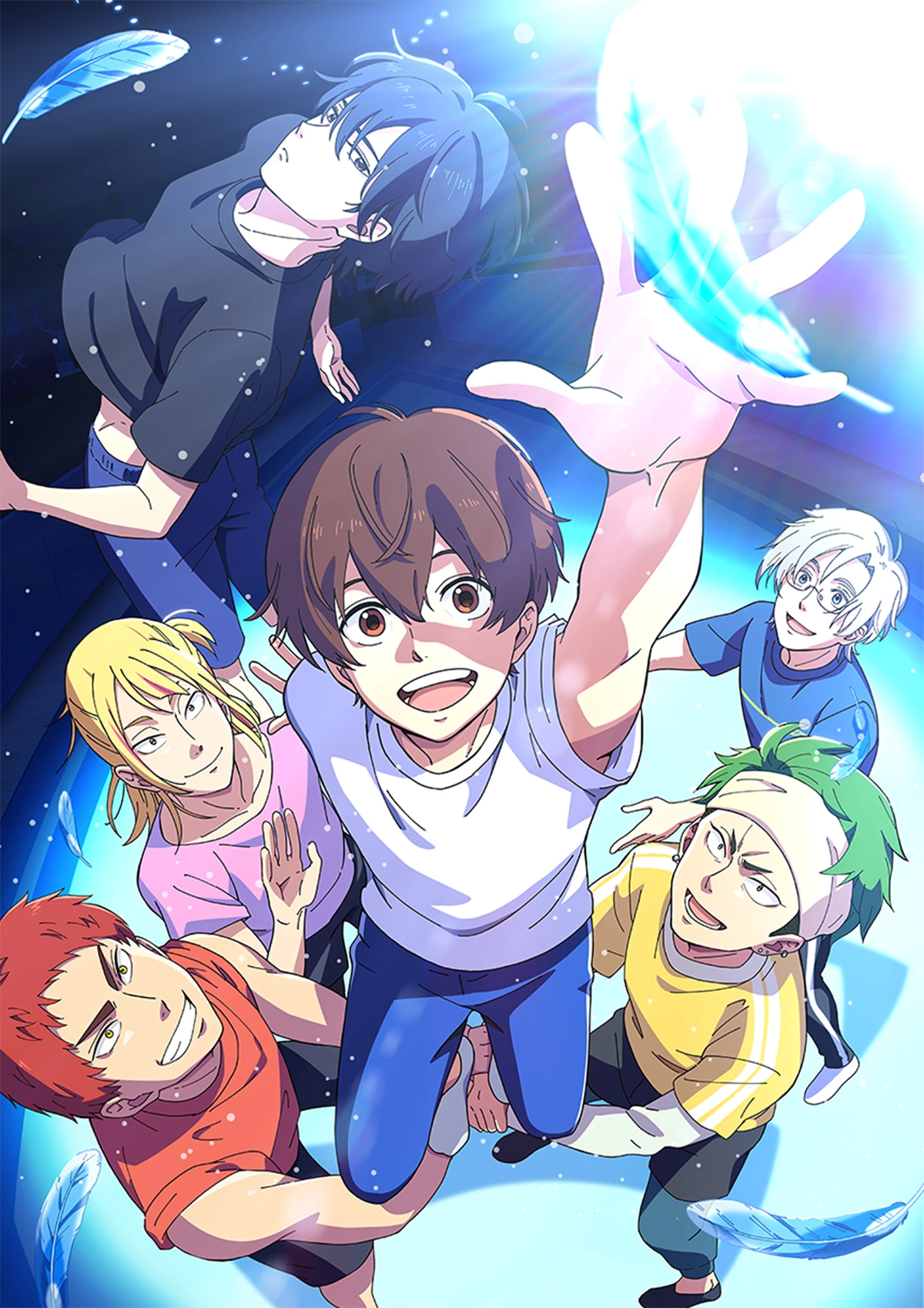
Shoutarou Futaba has always enjoyed sports, but he failed to advance beyond being a benchwarmer on his middle school baseball team. In a moment of whimsy, he decides to watch a rhythmic gymnastics tournament after noticing a group of gymnasts practicing in the park. While the Shoushukan High School Rhythmic Gymnastics Club performed well at the competition, it placed second-to-last due to penalties incurred for not fielding a full six-man roster.
Despite having no background in the sport, Shoutarou enrolls at Shoushukan in hopes of joining the team. He is recruited alongside Ryouya Misato, a prodigal gymnast who finished runner-up in a junior competition.
The team will compete in the upcoming Inter-High tournament with a full six-man roster. In order to stand a chance of winning the championship, Shoutarou must master the basics of rhythmic gymnastics while working closely with his new teammates.
Although it isn’t anything special or different from other sports anime, you can’t help but enjoy the whole series. It has endearing characters, with their unique personalities and quirkiness, but their interactions are so adorable and funny most of the time that you can’t help but like them all, no matter which team they belong to.
The overall theme of friendship and teamwork really draws you in, as our characters are in the world of gymnastics. We get to enjoy the wonderful humor, and you will find yourself chuckling or laughing loudly at the jokes in each episode, as well as appreciate the seriousness when things become serious. When watching this anime, there is almost never a dull moment.
Hoshiai no Sora
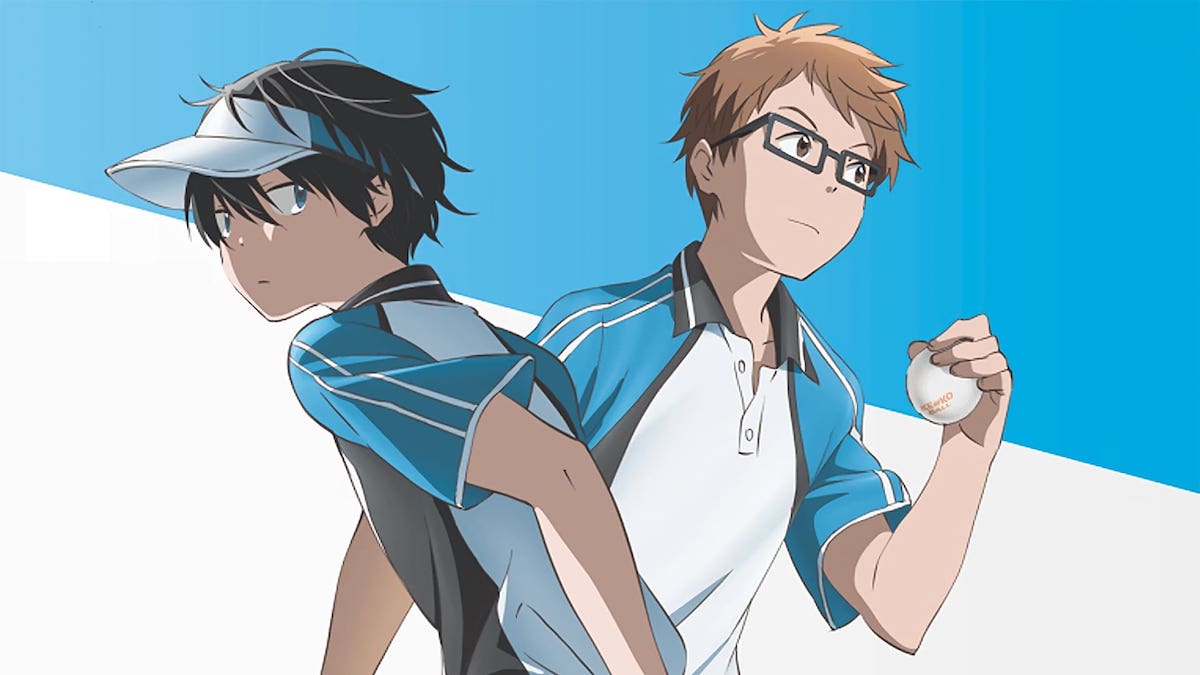
Due to their poor performance in matches and constant outperformance by the girls’ club, the boys’ soft tennis club faces disbandment. Toma Shinjou is desperate for members, so he tries scouting players but fails to find anyone.
Maki Katsuragi, a newly transferred student, shows great reflexes when he catches a stray cat in his classroom, instantly capturing Toma’s attention. Toma’s enthusiasm for Maki piques his ambition to invite him to join the boys’ team. Maki, however, declines because he does not wish to join any club. After refusing to back down, Toma convinces Maki-but only with the understanding that Toma will pay for Maki’s participation and cover other club costs.
Maki’s incredible form allows him to outperform the rest of the team immediately after joining the team. Though this causes conflict among the boys, Maki challenges his team members to not only keep up with his seemingly natural talent but to also devote themselves to the sport they once neglected.
As the boys’ soft tennis club discovers their own potential, they also endure personal hardships and deal with the darker side of growing up in middle school.
Characters are one of the best aspects of this show. It has a variety of interesting characters, and the character development is amazing. Each character in the cast has their own unique quirks and struggles, and many of the characters are relatable, and much of the show is spent developing them. You will be able to connect with at least one of the characters in this show, and the amount of care put into crafting these characters is apparent.
Hinomaruzumou
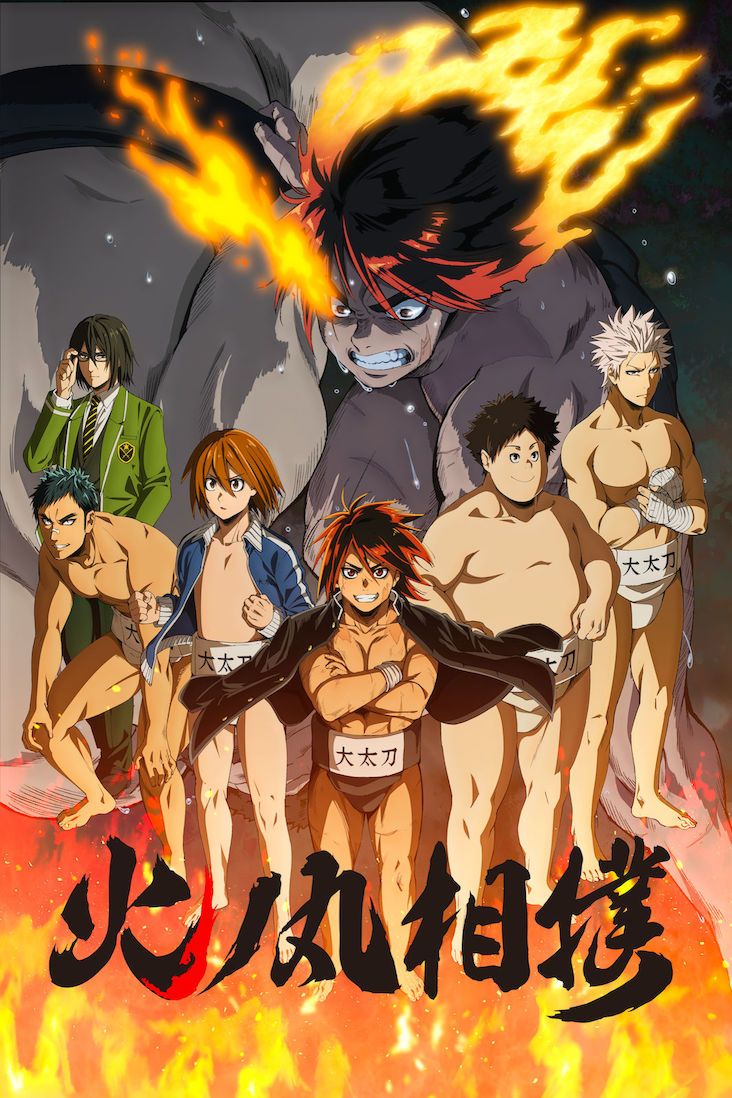
There are no weight classes in professional sumo. The strongest survive in this savage sport, and anyone willing to test their strength can enter the ring. Hinomaru Ushio, despite being incredibly talented and hardworking, does not meet the minimum size requirement to be a pro sumo wrestler.
Despite his small size, this boy is dreaming of reaching the summit of sumo, Hinoshita Kaisan. The only way he might go pro is if he becomes the High School Yokozuna, an honor bestowed on the best wrestler in high school competitions.
As well as being under pressure, Ushio has a deadline. His chances of going pro permanently are slim if he can’t prove his talent in the high school tournaments. He enrolls at Odachi High, rather than Japan’s top sumo school, Ishigami High, and must build a sumo club from scratch with a devout member named Shinya Ozeki.
Odachi High is considered the underdog of the sumo world, but if Ushio wants to succeed professionally, he has to push forward with all his strength.
There aren’t many animes that can really be described as being a perfect experience, but Hinomaruzumou undoubtedly comes close. It evokes powerful emotions every episode and has you on the edge of your seat for the outcomes of each sumo bout, which are never predictable and always have an enrapturing dramatic flare.
It is recommended for those who enjoy suspenseful action-based anime, martial art-based anime, or sport-based anime. This anime has all the elements to make it a great watch for anyone.
Girls & Panzer

“Senshadou” is an elimination-style sport played with tanks dating back to World War II. It’s advertised as an art form geared toward making ladies more prominent in culture and more appealing to men. Women and girls alike practice it. Over time, senshadou has become a world phenomenon, leading to the creation of a world championship that will soon be held in Japan.
After a devastating event led to her retirement from the sport, Miho Nishizumi, who comes from a lineage of senshadou experts, has developed a rift with her family. To avoid the practice as much as possible, she transfers to Ooarai Girls High School, where the senshadou program has been abolished. Following news of the upcoming championships, the school revives its tankery program, and Miho is pushed to join.
In order to save her school from closure, she must once again take command of a squadron of tanks while proving to her family that the Nishizumi-style of senshadou is not all about winning.
The show acknowledges and embraces its ridiculous premise and setting to deliver great comedy. No matter how ridiculous the situations or plot points are, it plays it straight and just lets you enjoy it without pointing out the joke.
As it puts clichés into stupid contexts and then blows them out of proportion, it mocks them. There will always be something there to make you laugh, the humor of the show is very consistent, and though it’s not the biggest draw of the show, it’s what helps to make the show so enjoyable.
Air Gear

Known as AT, Air Trecks are motorized, futuristic inline skates that are the latest craze sweeping the nation. The AT has a speed limiter, but a group of daredevils known as the “Storm Riders” is brave enough to bypass it. At underground battles, individual teams wage valuable AT parts or team emblems, their symbols of pride, in order to control the streets.
Itsuki Minami is a middle school student notorious for engaging in street fights who lives in this era. This reckless punk will break through any obstacle that stands in his way with his best friends Kazuma Mikura and Onigiri, always striving to reach heights no one else can reach. It is only when he discovers a pair of Air Trecks in his house that he is able to realize his true desire: to rule the skies.
What makes Air Gear so enjoyable is its focus on character development. The characters in Air Gear are pretty anime cliche, but they are well-developed. These characters are likable and relatable. The characters in the series have their humorous moments, whether they’re being perverted, clumsy, or plain sleazy. Although sometimes their actions are enough to make you wince, you’ll still fall in love with them all.
Air Gear might just look like a rollerblading show with anime additions, but this basic concept leads to an exciting anime. Quality of this average-length show is the pace of the story and the development of the characters, which will leave you feeling satisfied after each episode. Air Gear is a great choice if you are looking for an intense, action-packed sport.
Dumbbell Nan Kilo Moteru?
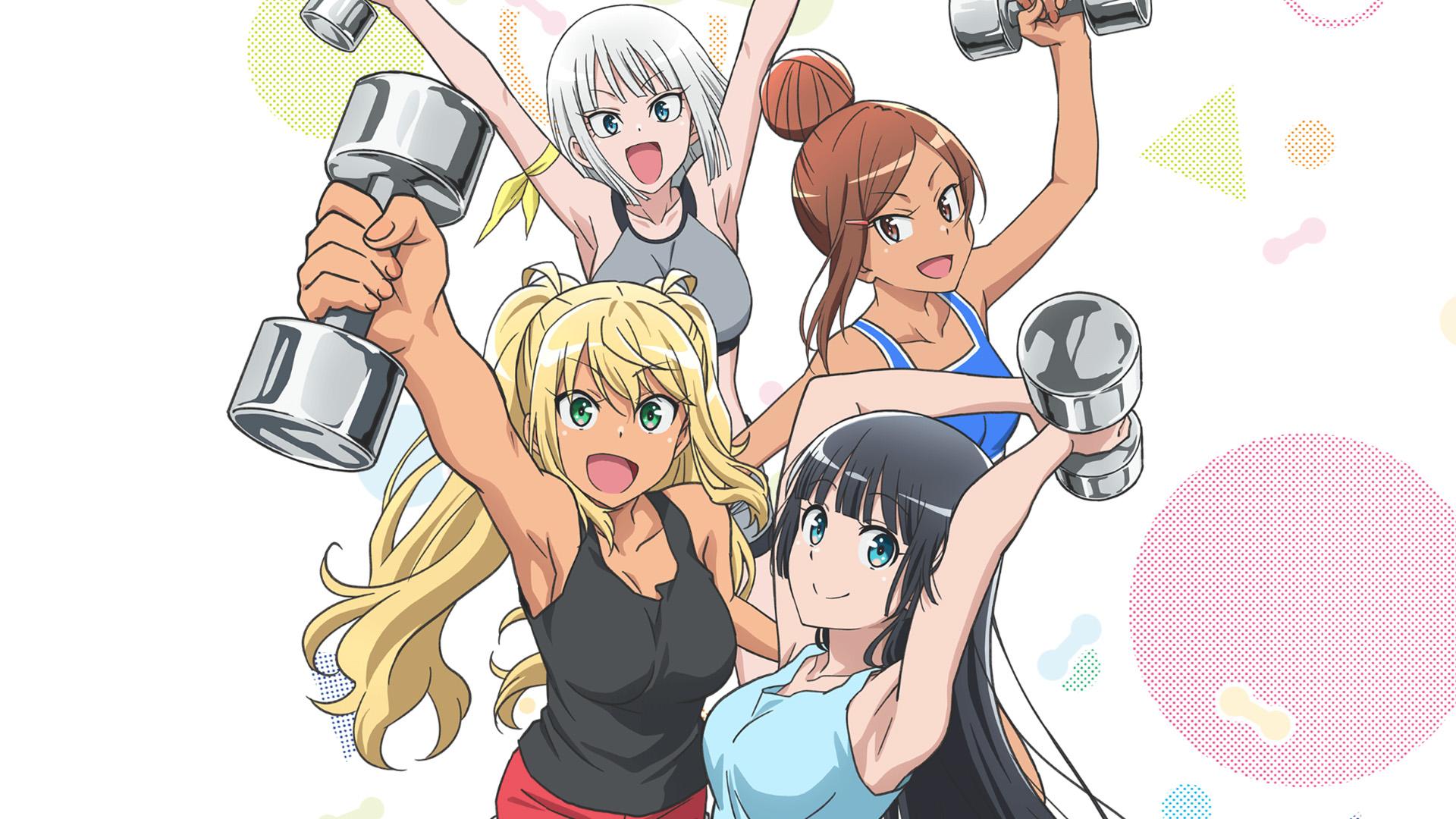
At a regular after-school food crawl, Hibiki Sakura’s best friend, Ayaka Uehara, confronts her about her growing waistline. When her attempts at solitary exercise fail miserably, Hibiki decides to join the newly opened Silverman Gym. Hibiki meets school idol and president of her student council Akemi Souryuuin at her orientation.
Hibiki soon discovers, however, that she is in for a lot more than she anticipated. In addition to having world-renowned bodybuilders and athletes in Silverman Gym, Akemi turns out to be a complete muscle fetishist! Hibiki is horrified by the scene unfolding in front of her eyes, so she tries to leave, but trainer Naruzou Machio stops her.
Enthralled by her newfound Prince Charming, Hibiki signs up for the gym. Due to her spur-of-the-moment decision, Hibiki now has to adapt to a new lifestyle.
Cute girls doing cute things has a mysterious power. An anime of this type has a subtle charm that encourages you to try new things. What the series manages to accomplish with its cast is impressive because, with simple character traits, it manages to deliver smooth and hilarious comedy.
Dumbbell Nan Kilo Moteru? certainly has tons of entertainment value, which is one of the most important factors in any form of media. This anime’s ability to transition between the hilariously relatable and more serious educational scenes is unmatched. This seamless tight rope walk is what makes the anime so enjoyable. It keeps the jokes always feeling fresh. Even the more repetitive gags are still hilarious until the final moments.
A plot isn’t much to be found in this anime, but what it lacks in plot it outdoes itself with cute, relatable characters and perfect punchlines.
Ahiru no Sora
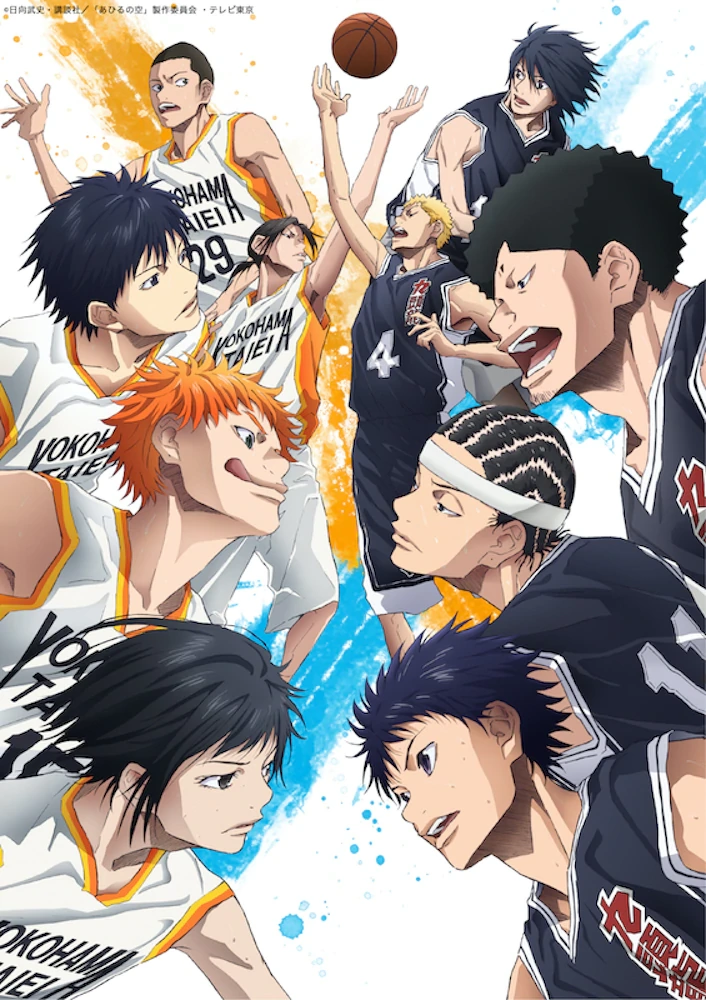
Sora Kurumatani has had to deal with his short height ever since he developed an interest in basketball, which is considered one of the most important assets in the game. The unwavering drive of Sora never let the fact that he was small hinder his ability to play, always pushing himself to the limit and practicing continuously to prove his abilities.
For the sake of satisfying his mother’s wishes, Sora enrolls at Kuzuryuu High School to be part of the basketball team and participate in tournaments. Sora is disappointed to learn that the boy’s basketball team is nothing but a retreat for punks with no interest in sports. Moreover, Sora learns that Momoharu Hanazono and Chiaki Hanazono-whom he becomes acquainted with-have also lost their once spirited motivation to play.
Aiming to revive the basketball team, Sora challenges the boys to a game against him, where his quick feet and swift movements overwhelm the group. Due to Sora’s impressive skills, sheer effort, and continuous dedication to basketball, the boys find their burnt-out passion for the sport rekindled once again.
In the series, basketball is the vehicle that drives these characters forward and plays a pivotal role in their quest to rebirth, but what it emphasizes is the importance of introspection to find something you truly love that can push you forward enough to give you a sense of purpose in life, regardless of mistakes one might make or the pain ahead.
It does all this with an exceptional level of nuance and subtlety, never genuinely shoving these themes down viewers’ throats but rather expecting them to pick up on hints given throughout much of the series.
Hanebado!
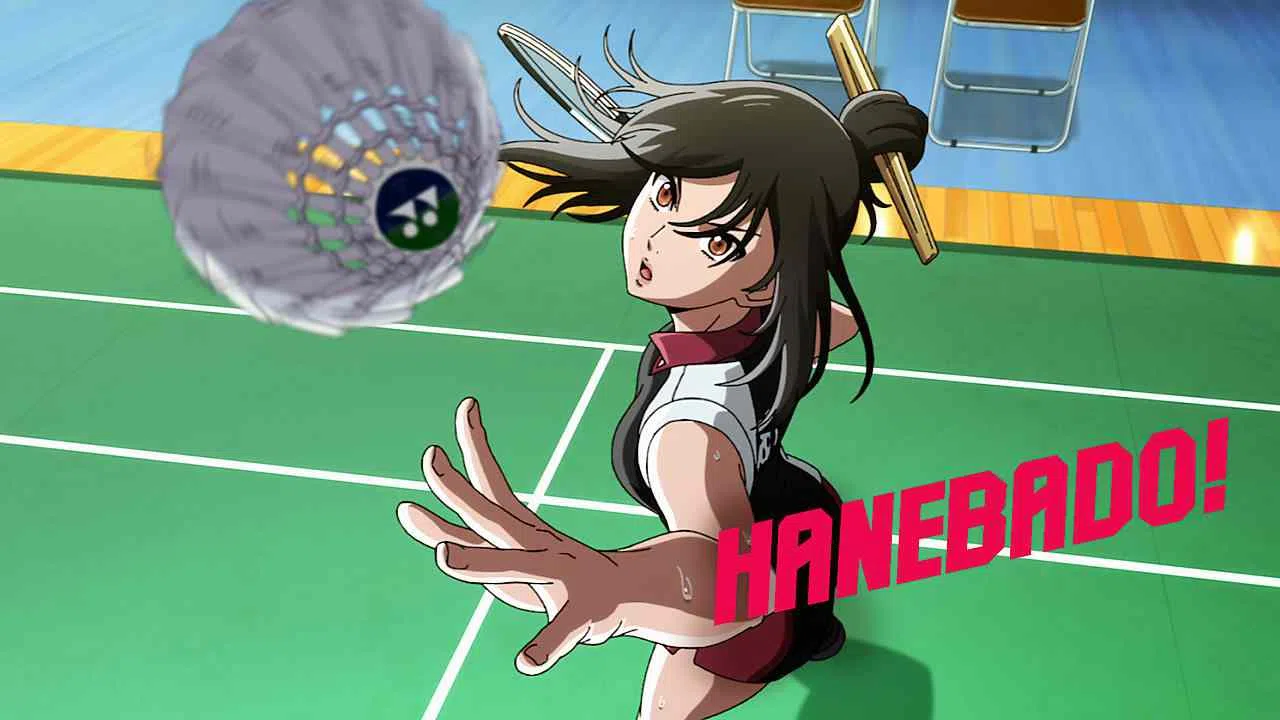
Nagisa Aragaki’s passion for badminton begins to erode after she loses 21-0 at the National Junior Badminton Tournament. Because of her shame at losing, she terrorizes the members of her high school badminton club. A few students have cried, while others have quit the club outright because of her grueling drills. Since the club is losing members and new prospects are too afraid to join, the future of the badminton club looks bleak.
That is until Kentarou Tachibana is hired as the new head coach. Besides being an Olympic-level player, he also brings a secret weapon: Ayano Hanesaki, the girl who defeated Nagisa six months ago.
Ayano is not the rival Nagisa remembers, but a girl with mixed feelings who wants to distance herself from badminton. With her future in sports now on the line, Nagisa must find a way to face her fears of inadequacy, heal her rival’s troubled heart, and bring victory to Kitakomachi High School’s badminton club.
As far as sports anime goes, Hanebado is one of the more realistic ones out there when it comes to the actual play of the game. Hanebado focuses more on two girls who overcome personal issues to better themselves, not only in Badminton but in life as well.
The characters are well-written, diverse, and memorable. Ayano’s rivals especially get fleshed out really well and get a good amount of character development. We get insight into their characters, their childhood, what shaped them to be the people they are now, and their motivation to play badminton.
Hanebado shows that not everyone is going to get along, and there will be some conflict/drama that arises in competitive sports, but we accept each other’s flaws or weaknesses and move on.
Suzuka
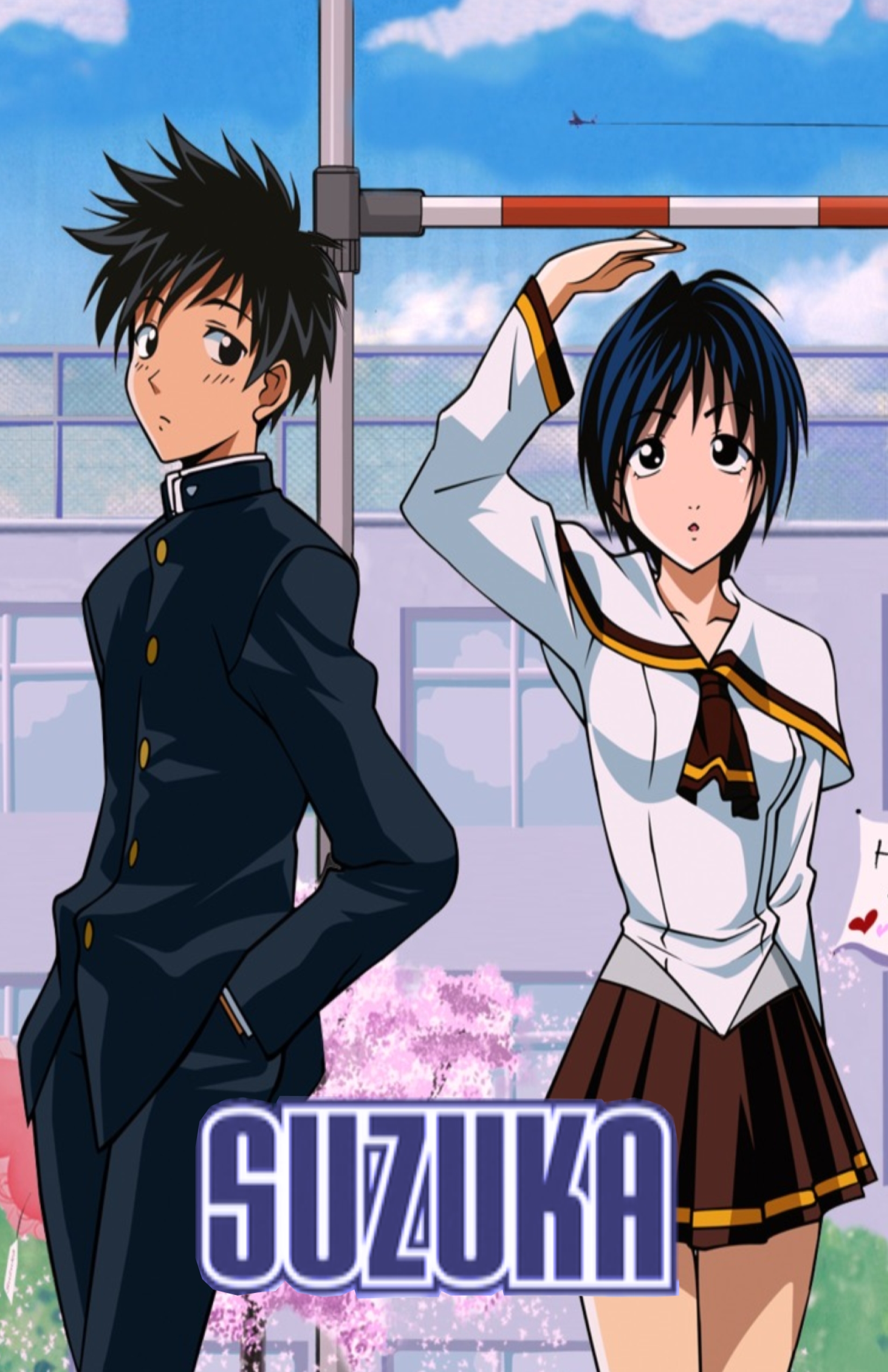
Yamato Akitsuki moved to Tokyo from the countryside to begin his high school career. He will assist his aunt and cousin in running their bathhouse, as well as the nearby girls’ dorm where he is staying, in exchange for room and board. A high jumper practicing her technique catches his attention as he passes by a high school track on his way to meet his relatives.
Yamato finds out later that the high jumper is not just another resident of the dorm but also a neighbor. Track and field athlete Suzuka Asahina is heavily scouted and attends the same high school he is. Suzuka, a perfectionist by nature, is turned off by Yamato’s carefree and clumsy personality and finds it difficult to be around him.
As a way to win her over, Yamato joins the track team after discovering he is a gifted sprinter. Through his experiences with the track team, his classmates, and the always inebriated college students in the dorm, Yamato becomes more determined to become a better athlete and a better companion to Suzuka, even if it means pushing himself to the point of exhaustion.
In the story, there is a focus on liking someone and doing something about it- it includes embarrassment, confusion, confessions, and other emotions when dealing with matters of the heart- everything that is easy to understand, empathize and relate to. Being in a high school setting gives the anime an innocent, naive, full of wonder and dreams atmosphere- perfect for romantic crushes during those dramatic teenage years.
There are many cliched moments throughout the show that you can probably predict what’s going to happen next, but that doesn’t prevent the show from being enjoyable.
All Out!
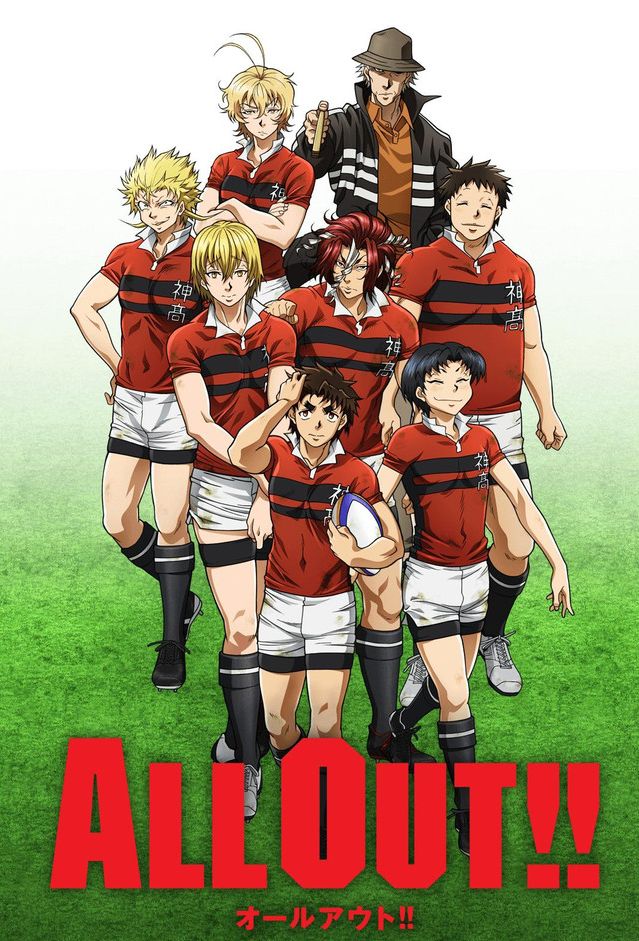
Anyone can be a star in rugby if they hold the ball. One player must carry the ball past the goalposts across the field while avoiding the opponent, who may use all their force to knock the ball away from them. The player can, however, pass to a teammate behind them or kick the ball before being tackled. In contrast to other sports, the game continues even if the player holding the ball is taken down.
High school freshman Kenji Gion is short but feisty at Kanagawa High School. Shortly after the school’s opening ceremony, he meets the tall and timid Sumiaki Iwashimizu, and the two of them get invited to see the rugby club in action.
Watching the match, Gion realizes that even though big and tall guys have an advantage, there are positions for everyone. Seeing that he can excel in this sport despite his short stature, he signs up, though Iwashimizu declines.
Iwashimizu’s excuses are not acceptable to Gion, who tries to drag him back into the sport. They intensify their training to prepare for Hanazono, the national high school rugby championships.
It’s not a story that’s out of the box or extremely unusual. But, even though the plot isn’t the most original, it’s entertaining enough to keep you watching. The characters are likable, and the cast has good chemistry, which is a huge plus.
Also, like a rugby match, the plot gets intense at times, but it also gives you a breather by having the characters take a break from training and use that time to dig into their backgrounds.
